Lithium stocks were hot a year ago, now they’re not. Brine projects in Argentina commanded rapt attention, now no one cares. Clay-hosted Lithium projects were non-starters 2-3 years ago, now they’re in the “maybe” column. Clay-hosted Lithium projects are “unconventional,” meaning untested, and therefore difficult or impossible to fund. However, “unconventional” need not mean difficult to move forward or impossible to fund. What if I told you about a company with a project that had relatively low-grade Lithium, is pre-PEA, and is located in southern Arkansas? Sounds attractive, right? No, it sounds highly….. “unconventional.” Last I checked, Arkansas was not in the heart of the Lithium Triangle.
Sometimes unconventional is not all bad. Standard Lithium (TSX-V: SLL) / (OTCQX: STLHF) is a company like no other, and that’s a good thing. Although pre-PEA (PEA now underway), Standard’s 150,000 acre Arkansas Lithium project, called the LANXESS project, has been de-risked in a surprising number of important ways. For instance, while other mining juniors talk about being near, “past producing mines,” the LANXESS project is currently in operation, at massive commercial scale — but producing Bromine from brine, not Lithium (yet). It is a past-producer, but also a present & future producer!
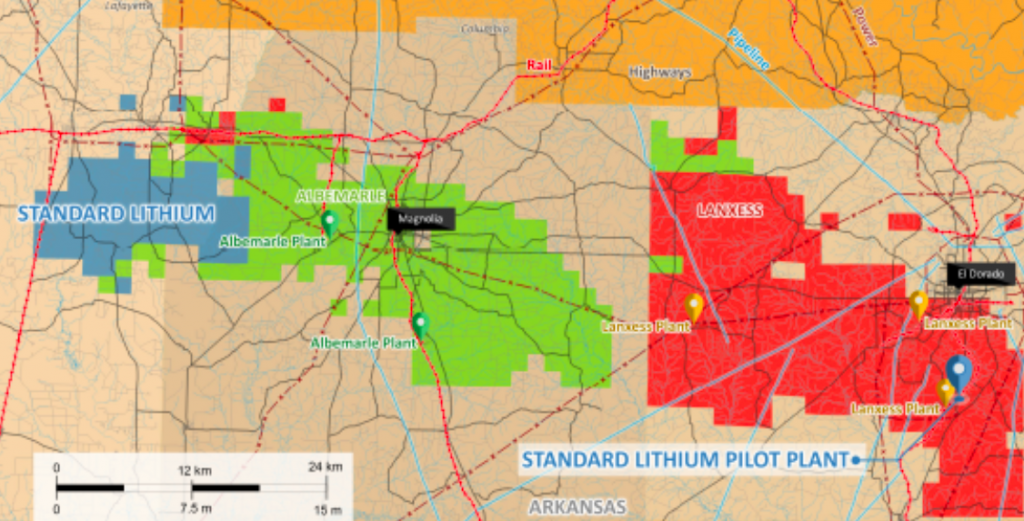
The LANXESS project is hardly early-stage. All of the project’s infrastructure is in place and currently in use. Power, rail, gas, water, tanks, chemicals, pumps, tankers, trucks, drilling equipment, wells, roads, pipelines, etc. 24/7/365, dozens of wells are pumping billions of gallons of brine (salty water), annually, containing Bromine, Lithium and other elements, through 3 nearby processing facilities. The LANXESS project happens to be smack in the middle of North America’s largest brine production & processing facilities. These facilities have been in operation for decades.
Think about the risks avoided here. The Project is in the U.S., thousands of experienced workers are in place working, there’s no discovery or resource expansion risk (the resource is already large enough), the Project is by and large already permitted, it’s in environmental compliance. There’s local community support (no Aboriginal or First Nations issues).
Year-round operations, port access in the Gulf of Mexico, workers go home each night (no fly-in / fly-out). Best of all, the Project is in commercial-scale operation right now, albeit for Bromine. These are logistical items that Lithium companies in Argentina & Chile, not to mention Australia & Canada, would die for, milestones that can take years and hundreds of millions of dollars to obtain.
Not only are operations in place at a large commercial scale, but pumping history, hydrology & geology is all readily available to Standard Lithium for review. This and other data enabled the Company to estimate a 3.1 M metric tonne Lithium Carbonate Equiv. (“LCE“) Inferred resource at the LANXESS project. So, we can be reasonably certain that there’s considerable resource size. However, to be safe we await the Inferred resource being converted to Measured & Indicated, which is expected later this year.
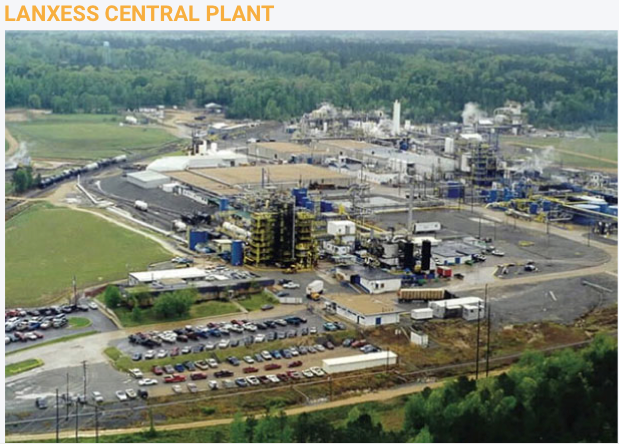
One might think that pulling Lithium out along with the Bromine would be straightforward, it’s not, it proved to be quite a technical challenge. However, a challenge on the verge of being solved, as Standard Lithium is operating a mini pilot plant that has already produced battery-grade Lithium Carbonate. However, this process needs to be scaled up very significantly.
I’ve mentioned several ways in which the Company’s Project is de-risked, taking that theme to a whole new level is a prospective JV with LANXESS (hence the project name). Standard Lithium signed a MOU with LANXESS in May 2018 and a JV term sheet in November. LANXESS is a giant German chemical conglomerate that would provide substantial help on the technical, operational, sales / marketing and R&D fronts.
Assuming reasonable project economics, LANXESS has committed to finance 100% of the commercialization of the Project. LANXESS’, (through its wholly-owned subsidiary) Great Lake Chemicals, operations in Southern Arkansas encompass more than 150,000 acres, 10,000 brine leases & surface agreements and 250 miles of pipelines. LANXESS extracts brine from wells located throughout the area and transports it to 3 Arkansas processing plants through a network of pipelines.
Executing the JV would be huge, LANXESS would own a majority of the Project, but funding is without question the largest risk factor these days. LANXESS funding would be the biggest de-risking event of them all. Several world-class brine projects in Argentina are all but stalled due to a lack of project funding. That’s even though those projects are “conventional” proposing to use conventional solar evaporation ponds. And then there’s Quebec’s Nemaska Lithium, they were billed as fully-funded, until they found a ~C$400M hole in their funding basket. Nothing against Nemaska, Lithium projects are complex and unique. Delays and cost over-runs are the norm.
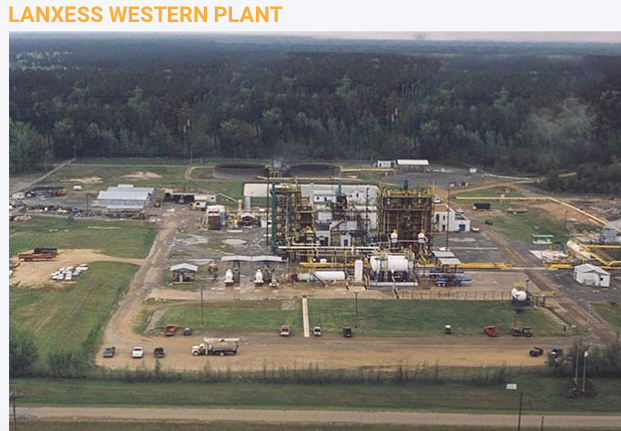
Standard Lithium’s processing technology, if operating at commercial scale, would process enormous volumes of brine in days vs. over a year for solar evaporation ponds. The technology is designed to be easily and conveniently scalable, it’s modular. If need be, the Company could plan production based on market conditions. Management is not going to run into a ~C$400M cap-ex problem, the amount of operating data available is immense and remember, most of the infrastructure is already in place.
So, what does all of this mean for Standard Lithium? Assuming LANXESS comes on board (LANXESS named Standard Lithium and the Arkansas lithium project during the opening minutes of their 4th Quarter earnings call), they have many risk factors covered, including the biggest risk, project funding. Instead of facing the daunting task of having to raise hundreds of millions in equity capital to fund a commercial development, the Company is probably looking at raising closer to C$25M over the next 18 months. They just closed an C$11M bought deal financing.
Risk Factors
The main risk factor is scaling their proprietary technology from pilot to commercial-scale. With regard to this risk, I think it’s a question of when, not if, the Company achieves this milestone. A moderate delay would be disappointing but would not deliver a fatal blow. Standard Lithium hopes to eventually reach a run-rate of ~20,000 tonnes/yr. LCE. That will likely take several years, after first achieving limited commercial production potentially as early as 2021. Ultimately, production of 30,000+ tonnes/yr. LCE for decades is a possibility, by optimizing the well fields and tapping into the Company’s nearby TETRA Project area.
What might the mid-year PEA show? We don’t know yet, but we can make some educated guesses. Cap-ex? In Argentina, the average Lithium brine project cap-ex requirement from among 6 well known projects is C$540 M. The LANXESS project will be built in stages, so the cap-ex will be substantially lower. Remember, most of the infrastructure is already in place and in operation.
Op-ex should be on the low side as well. For example, the Company has ready access to some of the cheapest chemical reagents in the world. And, the Lithium operations will be sharing some costs with the Bromine operations. Brine exits the Bromine operations at 70 degrees Celsius, so no extra energy needs to be added as it enters the Lithium facilities. Management’s goal is to be in the bottom quartile on the cost curve.
Look at “conventional” brine producer Orocobre Ltd., it’s in year 4 of commercial operation, but is still running at ~70%-80% of nameplate capacity. This is no knock on Orocobre, they were the first new brine project in Argentina in 20 years, it just demonstrates how very difficult each unique brine (chemistry) project is. And the weather, it has been surprisingly rainy this year and last, which is bad news for solar evaporation ponds. Global warming?
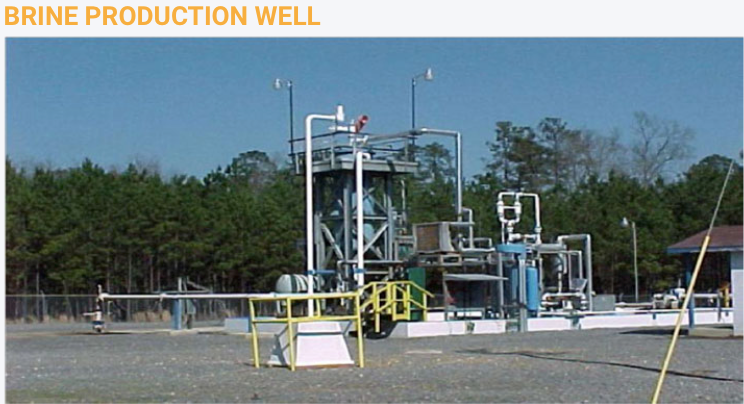
In the early-to-mid 2020s there will be fierce competition for scarce resources in Argentina (labor, executives with brine project building experience, consultants, water, power, mining services & equipment, environmental work & construction activities (at 4,000 meter elevations), access to governmental agencies for permits & approvals). Among the 6-10 brine projects in Argentina at PEA-stage or more advanced, several might never reach production. Several others could be delayed by 1,2,3,4 years in reaching nameplate capacities of 20k-35k tonnes/yr. LCE.
Conclusion
Standard Lithium (TSX-V: SLL) / (OTCQX: STLHF) will not be fighting for scarce resources, (another risk avoided) there should be no operating or infrastructure bottlenecks, the weather is not a factor. There won’t be cost blowouts. If a Bank Feasibility Study calls for first production in mid-2021, and LANXESS is committed to project finance, operations & off-take, it will likely happen pretty much on time and on budget.
For hard rock producers in western Australia my understanding is that the situation is a lot better, but we could still see bottlenecks as many hard rock producers try to ramp up supply at the same time. Instead of companies failing, perhaps we will see a wave of M&A in western Australia.
That higher degree of certainty is worth a lot in the wild west of Lithium project development. And, if the brine projects in the Lithium Triangle can’t deliver close to nameplate capacity in the early-to-mid-2020’s, there’s going to be tremendous demand for Standard Lithium’s output, and Lithium prices will likely be high. Who knows, maybe even the “unconventional” clay-hosted Lithium producers will have their day in the sun?
March 29, 2019
Peter Epstein
Disclosures: The content of this article is for information only. Readers fully understand and agree that nothing contained herein, written by Peter Epstein of Epstein Research [ER], (together, [ER]) about Standard Lithium, including but not limited to, commentary, opinions, views, assumptions, reported facts, calculations, etc. is not to be considered implicit or explicit investment advice. Nothing contained herein is a recommendation or solicitation to buy or sell any security. [ER] is not responsible under any circumstances for investment actions taken by the reader. [ER] has never been, and is not currently, a registered or licensed financial advisor or broker/dealer, investment advisor, stockbroker, trader, money manager, compliance or legal officer, and does not perform market making activities. [ER] is not directly employed by any company, group, organization, party or person. The shares of Standard Lithium are highly speculative, not suitable for all investors. Readers understand and agree that investments in small cap stocks can result in a 100% loss of invested funds. It is assumed and agreed upon by readers that they will consult with their own licensed or registered financial advisors before making any investment decisions.
At the time this article was posted, Peter Epstein owned shares of Standard Lithium and the Company was an advertiser on [ER]. Readers understand and agree that they must conduct their own due diligence above and beyond reading this article. While the author believes he’s diligent in screening out companies that, for any reasons whatsoever, are unattractive investment opportunities, he cannot guarantee that his efforts will (or have been) successful. [ER] is not responsible for any perceived, or actual, errors including, but not limited to, commentary, opinions, views, assumptions, reported facts & financial calculations, or for the completeness of this article or future content. [ER] is not expected or required to subsequently follow or cover events & news, or write about any particular company or topic. [ER] is not an expert in any company, industry sector or investment topic.
- Please click here now. Double-click to enlarge this long-term gold chart. Fundamental and technical analysis are both strongly supporting gold’s rally towards the key $1400 area.
- Having said that, COMEX price action mainly reflects action in the physical market and this is the weak season for gold.
- Investors need patience. News in the West that “should” push gold $100/ounce higher is in play, but modest physical market demand in China and India means that rallies are modest.
- Please click here now. If this news was happening during the Chinese New Year Jan-Feb peak physical demand time frame, gold would be staging a “barn burner” rally.
- Instead, it’s contained in a $1280-$1350 consolidation range.
- Please click here now. Double-click to enlarge this daily gold chart.
- The bottom line: Gold is on a journey to the $1400-$1420 price zone, but it’s not a rocket ride. It’s more of what I call a “bull era plod”.
- The other fact to keep in mind is that the inversion of the US yield curve with artificially low rates isn’t suggesting that American economic growth is “cratering”.
- Growth is slowing down, but it’s too early to predict that a recession is imminent. A US-China trade deal could provide some medium-term support for stock markets without being negative for gold.
- Central bank gold accumulation is another positive factor, but it’s currently only about 50-60 tons a month. In the weak season Chindian demand often drops from 200+ tons a month to about 60-80.
- Central bank and Western fear trade demand is decent, but isn’t making up for the shortfall caused by the drop in Chindian demand. That’s being reflected in commercial trader action on the COMEX.
- Gold is rallying strongly from the $1280 zone because Chindian dealers are buyers there. They are fading their buying in the $1310-$1320 area, leaving Western money managers to do the heavy lifting. That’s no easy task with Chindia quiet.
- To put it simply, Western financial news is gold-supportive in content, but until Chindian buying resumes in size gold will be more of a trader’s market than the start of a “huge bull run”.
- The good news is that $1280-$1350 gold is a great price for the miners, and many are surging to one fresh high after another!
- Please click here now. Double-click to enlarge this fabulous GDX chart.
- I’ve suggested that a Friday close of $23 or higher for GDX and $14 for Barrick (GOLD-NYSE) would open the door to a much more significant rally for most gold and silver mining stocks.
- GDX closed above $23 yesterday and Barrick closed above $14. It’s not Friday yet, but this is a very positive sign!
- I don’t expect gold to move above $1350 until Chindian demand begins to strengthen in August… unless there’s a major economic shock in the West.
- Having said that, when it does rise to $1400-$1420, I expect a massive bull run to occur in the miners.
- The logic for this outlook is that most analysts have underestimated the profits that miners will make at $1400+, and global stock markets are likely to swoon again in the Aug-Oct crash season.
- In Sept 2018, gold was in the $1200 range. If it is in the $1400 area in Sept 2019 with stock markets swooning, institutional money managers could engage in a gold stock buying frenzy!
- A September rate cut from the Fed to calm the panic would likely enhance the frenzy.
- Please click here now. Double-click to enlarge this silver stock ETF chart.
- Note the recent rise of the key TRIX indicator above the zero line. That’s the sign of a technically healthy market. A sustained bull run for silver stocks would be signalled by a Friday SIL-NYSE close above $30!
Special Offer For Website Readers: Please send me an Email to freereports4@gracelandupdates.com and I’ll send you my free “Barrick & Agnico Lead The Juniors Higher!” report. I highlight money making tactics for Barrick, Agnico, and key juniors that are joining the upside fun!
Thanks!!
Cheers
Stewart Thomson
Email:
Graceland Updates daily between 4am-7am. They are sent out around 8am-9am. The newsletter is attractively priced and the format is a unique numbered point form. Giving clarity of each point and saving valuable reading time.
Risks, Disclaimers, Legal
Stewart Thomson is no longer an investment advisor. The information provided by Stewart and Graceland Updates is for general information purposes only. Before taking any action on any investment, it is imperative that you consult with multiple properly licensed, experienced and qualified investment advisors and get numerous opinions before taking any action. Your minimum risk on any investment in the world is: 100% loss of all your money. You may be taking or preparing to take leveraged positions in investments and not know it, exposing yourself to unlimited risks. This is highly concerning if you are an investor in any derivatives products. There is an approx $700 trillion OTC Derivatives Iceberg with a tiny portion written off officially. The bottom line:
Are You Prepared?
Since last spring we’ve written over and over again about a Fed rate cut being the catalyst for a bull move in gold stocks.
The history is almost bulletproof. Many lows in gold stocks over the past 60 years coincided with the end of rate hikes.
At present the Federal Reserve is in pause mode and the market is on the cusp of pricing in a rate cut. Friday, Fed funds futures showed a 56% chance of a rate cut by January 2020.
However, precious metals have yet to make new 52-week highs. The gold stocks (GDX & GDXJ) are much closer to doing so than the metals.
Simply waiting for the Fed to cut rates risks missing out on some upside. As market timers, we have to anticipate it.
Is there a leading indicator for the Fed moving from a pause to a cut?
Take a look at the chart below in which we plot data from the last two instances of new rate cut cycles: 2001 and 2007. The vertical lines highlight the Fed’s first cut in those two cycles.
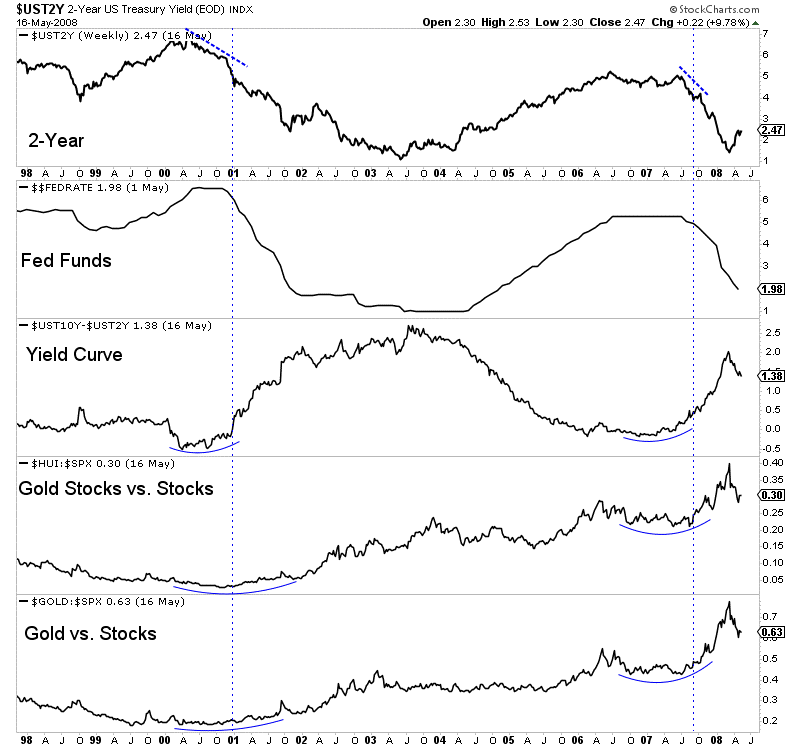
There are several observations to make.
First, Gold and gold stock relative performance accelerated after the rate hikes.
Second, the 10-year and 2-year yield spread began to steepen prior to that outperformance and prior to the rate cuts. And that’s because the 2-year yield, which is a proxy for the Fed funds rate, was trending lower in advance of the first cut.
In short, the sharp decline in the 2-year yield preceded the Fed moving from a pause to a cut. Prior to both the 2001 and 2007 cuts, the 2-year yield had declined by over 1%.
How does this compare to today?
The yield curve has yet to steepen and precious metals have not begun or confirmed outperformance against the stock market.
However, the positive sign for precious metals is the 2-year yield has already declined from nearly 3% down to 2.24% as we pen this.
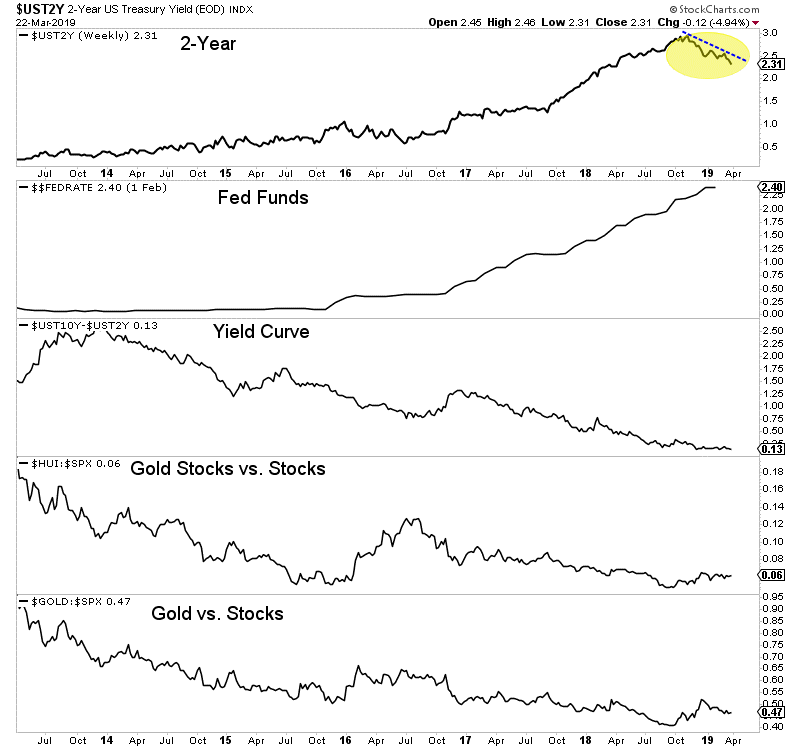
Every cycle is different and each has its own nuances but we cannot ignore the current decline in the 2-year yield. The closer it gets to 2.00%, the more the market will price in a rate cut.
With its decline to 2.24% today (Monday) the market has now priced in a 73% chance of a rate cut by January 2020. Not surprisingly, precious metals are trading higher.
If the 2-year yield continues to decline then precious metals (and gold stocks especially) should build more and more evidence that they are in a new bull market. To learn what stocks we are buying and think have 3x to 5x potential, consider learning more about our premium service.
Here are today’s videos and charts (double-click to enlarge):
SFS Key Charts, Signals, & Video Analysis
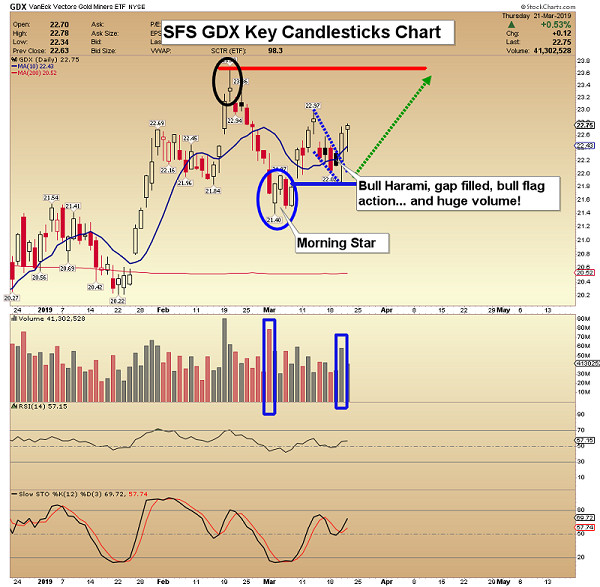
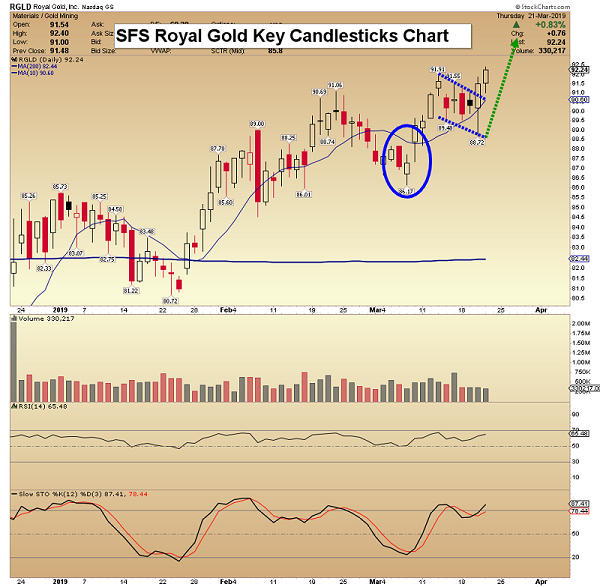
SF60 Key Charts, Signals, & Video Analysis
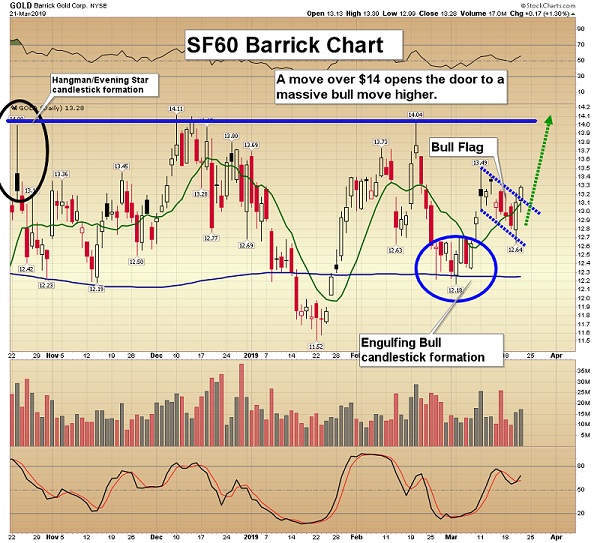
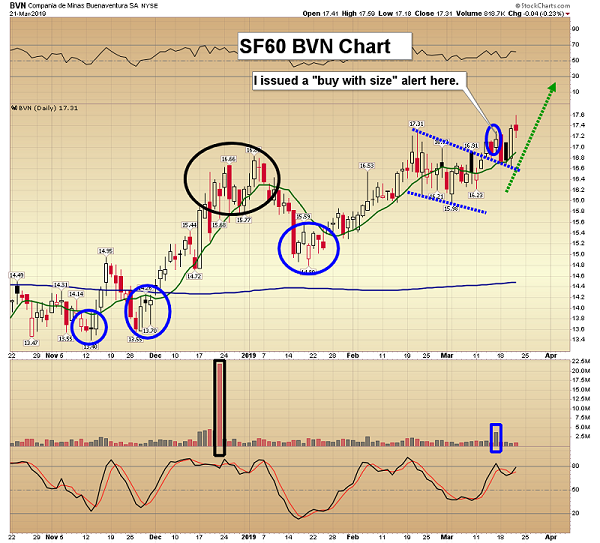
SF Trader Key Charts, Signals, & Video Analysis
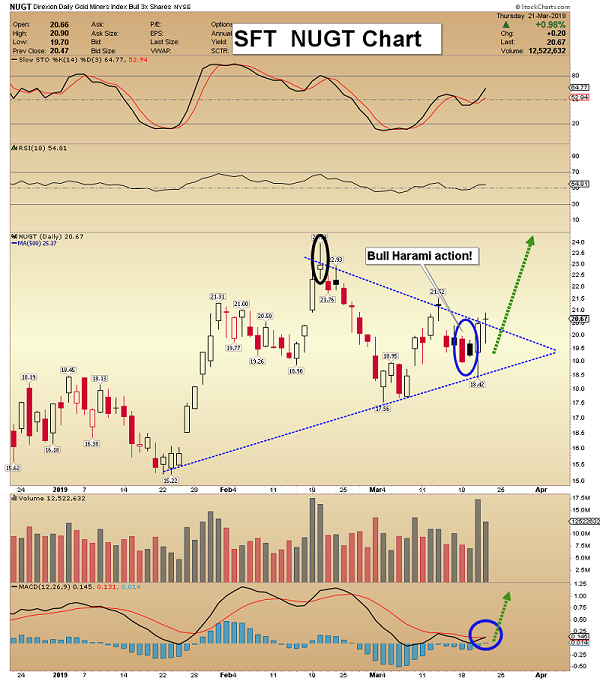
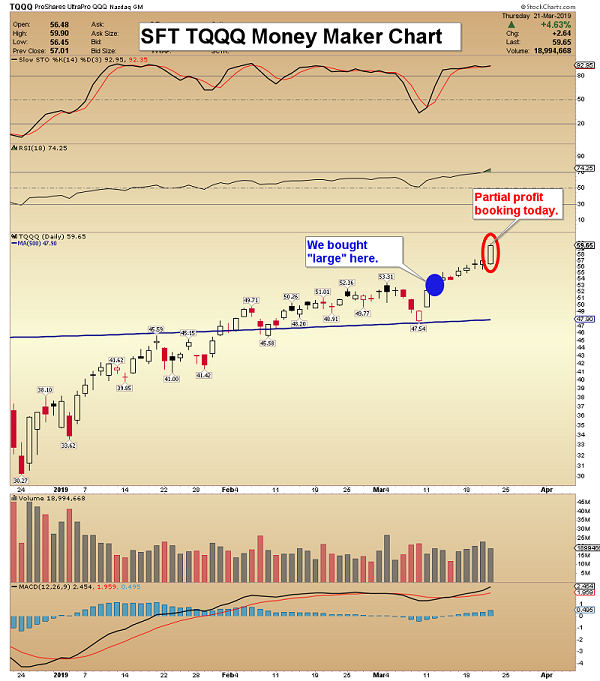
SFJ Key Charts, Signals, & Video Analysis
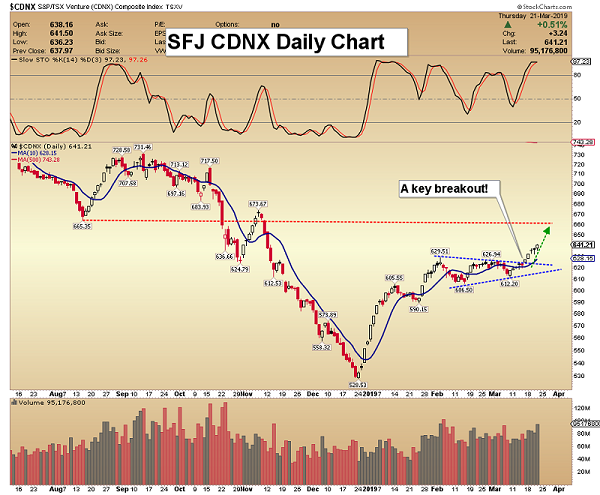
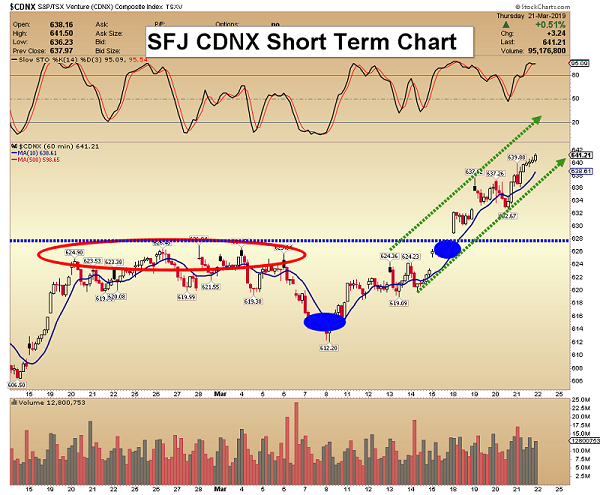
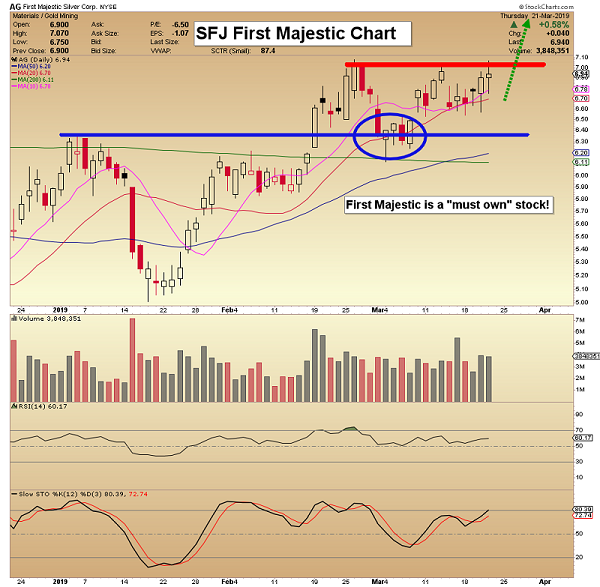
March 26, 2019
Morris Hubbartt
Unique Introduction For Website Readers: Send me an email to signals@superforcesignals.com and I’ll send you my free “Candlesticks Of Thunder!” junior gold stocks video report. I’ll also include 3 of my next Super Force Surge Signals free of charge, as I send them to paid subscribers. Thank you!
Stay alert for our Super Force alerts, sent by email to subscribers, for both the daily charts on Super Force Signals at www.superforcesignals.com and for the 60 minute charts at www.superforce60.com
About Super Force Signals:
Our Super Force signals are created thru our proprietary blend of the highest quality technical analysis and many years of successful business building. We are two business owners with excellent synergy. We understand risk and reward. Our subscribers are generally successful business owners, people like yourself with speculative funds, looking for serious management of your risk and reward in the market.
Frank Johnson: Executive Editor, Macro Risk Manager.
Morris Hubbartt: Chief Market Analyst, Trading Risk Specialist.
Email:
The mid-tier gold miners’ stocks have been rallying on balance in recent months, carving a solid young upleg. They’ve mostly finished reporting their latest fourth-quarter results, revealing how they are faring fundamentally. Their operating and financial performance is very important for investors, as the mid-tier realm is where most of the gold-stock sector’s gains accrue. They fared really well in a challenging quarter.
Four times a year publicly-traded companies release treasure troves of valuable information in the form of quarterly reports. Required by the U.S. Securities and Exchange Commission, these 10-Qs and 10-Ks contain the best fundamental data available to traders. They dispel all the sentiment distortions inevitably surrounding prevailing stock-price levels, revealing corporations’ underlying hard fundamental realities.
While 10-Qs with filing deadlines of 40 days after quarter-ends are required for normal quarters, 10-K annual reports are instead mandated after quarters ending fiscal years. Most gold miners logically run their accounting on calendar years, so they issue 10-Ks after Q4s. Since these annual reports are larger and must be audited by independent CPAs, their filing deadlines are extended to 60 days after quarter-ends.
The global nature of the gold-mining industry complicates efforts to gather this all-important fundamental data. Many mid-tier gold miners trade in Australia, South Africa, Canada, the United Kingdom, and other countries with quite-different reporting requirements. These include half-year reporting rather than quarterly, long 90-day filing deadlines after year-ends, and dissimilar presentations of operating and financial results.
The definitive list of mid-tier gold miners to analyze comes from the GDXJ VanEck Vectors Junior Gold Miners ETF. Despite its misleading name, GDXJ is largely dominated by mid-tier gold miners and not juniors. GDXJ is the world’s second-largest gold-stock ETF, with $4.1b of net assets this week. That is only behind its big-brother GDX VanEck Vectors Gold Miners ETF that includes the major gold miners.
Major gold miners are those that produce over 1m ounces of gold annually. The mid-tier gold miners are smaller, producing between 300k to 1m ounces each year. Below 300k is the junior realm. Translated into quarterly terms, majors mine 250k+ ounces, mid-tiers 75k to 250k, and juniors less than 75k. GDXJ was originally launched as a real junior-gold-stock ETF as its name implies, but it was forced to change its mission.
Gold stocks soared in price and popularity in the first half of 2016, ignited by a new bull market in gold. The metal itself awoke from deep secular lows and surged 29.9% higher in just 6.7 months. GDXJ and GDX skyrocketed 202.5% and 151.2% higher in roughly that same span, greatly leveraging gold’s gains. As capital flooded into GDXJ to own junior gold stocks, this ETF risked running afoul of Canadian securities laws.
Canada is the center of the junior-gold universe, where most juniors trade. Once any investor including an ETF buys up a 20%+ stake in a Canadian stock, it is legally deemed a takeover offer. This may have been relevant to a single corporate buyer amassing 20%+, but GDXJ’s legions of investors certainly weren’t trying to take over small gold miners. GDXJ diversified away from juniors to comply with that archaic rule.
Smaller juniors by market capitalization were abandoned entirely, cutting them off from the sizable flows of ETF capital. Larger juniors were kept, but with their weightings within GDXJ greatly demoted. Most of its ranks were filled with mid-tier gold miners, as well as a handful of smaller majors. That was frustrating, but ultimately beneficial. Mid-tier gold miners are in the sweet spot for stock-price-appreciation potential!
Major gold miners are increasingly struggling with declining production, they can’t find or buy enough new gold to offset their depletion. And the stock-price inertia from their large market capitalizations is hard to overcome. The mid-tiers can and are boosting their gold output, fueling big growth in operating cash flows and profitability. With much-lower market caps, capital inflows drive their stock prices higher much faster.
Every quarter I dive into the latest results from the top 34 GDXJ components. That’s simply an arbitrary number that fits neatly into the tables below, but a commanding sample. These companies represented 82.1% of GDXJ’s total weighting this week, even though it contained a whopping 71 stocks! 6 of the top 34 were majors mining 250k+ ounces, 17 mid-tiers at 75k to 250k, 8 “juniors” under 75k, and 3 explorers with zero.
These majors accounted for 19.8% of GDXJ’s total weighting, and really have no place in a “Junior Gold Miners ETF” when they could instead be exclusively in GDX. These mid-tiers weighed in at 44.3% of GDXJ. The “juniors” among the top 34 represented just 14.8% of GDXJ’s total. But only 4 of them at a mere 6.1% of GDXJ are true junior golds, meaning they derive over half their revenues from actually mining gold.
The rest are primary silver miners, gold-royalty companies, and gold streamers. GDXJ is overwhelmingly a mid-tier gold miners ETF, with sizable small-major exposure. Investors and speculators need to realize it is not a junior-gold investment vehicle as advertised. GDXJ also has major overlap with GDX. Fully 28 of these top 34 GDXJ gold miners are included in GDX too, with 23 of them also among GDX’s top 34 stocks.
The GDXJ top 34 accounting for 82.1% of its total weighting also represent 36.6% of GDX’s own total weighting! The GDXJ top 34 clustered between the 11th- to 40th-highest weightings in GDX. Thus over 4/5ths of GDXJ is made up by almost 3/8ths of GDX. But GDXJ is far superior, excluding the large gold majors struggling with production growth. GDXJ gives much-higher weightings to better mid-tier miners.
The average Q4’18 gold production among GDXJ’s top 34 was 164k ounces, just over half as big as the GDX top 34’s 302k average. Despite these two ETFs’ extensive common holdings, GDXJ is increasingly outperforming GDX. GDXJ holds many of the world’s best mid-tier gold miners with big upside potential as gold’s own bull gradually powers higher. Thus it is important to analyze GDXJ miners’ latest results.
So after every quarterly earnings season I wade through all available operational and financial results and dump key data into a big spreadsheet for analysis. Some highlights make it into these tables. Any blank fields mean a company hadn’t reported that data as of this Wednesday. The first couple columns show each GDXJ component’s symbol and weighting within this ETF as of this week. Not all are US symbols.
19 of the GDXJ top 34 primarily trade in the US, 5 in Australia, 8 in Canada, and 2 in the U.K. So some symbols are listings from companies’ main foreign stock exchanges. That’s followed by each gold miner’s Q4’18 production in ounces, which is mostly in pure-gold terms excluding byproducts often found in gold ore like silver and base metals. Then production’s absolute year-over-year change from Q4’17 is shown.
Next comes gold miners’ most-important fundamental data for investors, cash costs and all-in sustaining costs per ounce mined. The latter directly drives profitability which ultimately determines stock prices. These key costs are also followed by YoY changes. Last but not least the annual changes are shown in operating cash flows generated, hard GAAP earnings, revenues, and cash on hand with a couple exceptions.
Percentage changes aren’t relevant or meaningful if data shifted from positive to negative or vice versa, or if derived from two negative numbers. So in those cases I included raw underlying data rather than weird or misleading percentage changes. In cases where foreign GDXJ components only released half-year data, I used that and split it in half where appropriate. That offers a decent approximation of Q4’18 results.
Symbols highlighted in light blue newly climbed into the ranks of GDXJ’s top 34 over this past year. And symbols highlighted in yellow show the rare GDXJ-top-34 components that aren’t also in GDX. If both conditions are true blue-yellow checkerboarding is used. Finally production bold-faced in blue shows the handful of junior gold miners in GDXJ’s higher ranks, under 75k ounces quarterly with over half of sales from gold.
This whole dataset together compared with past quarters offers a fantastic high-level read on how mid-tier gold miners as an industry are faring fundamentally. While Q4’18 proved challenging with lower average gold prices, the GDXJ miners generally weathered it well. These elite mid-tier miners did much better last quarter than the major-dominated GDX elites. Their profits and stock prices are ready to soar with higher gold.
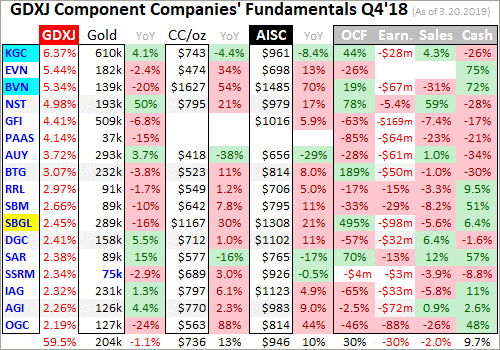
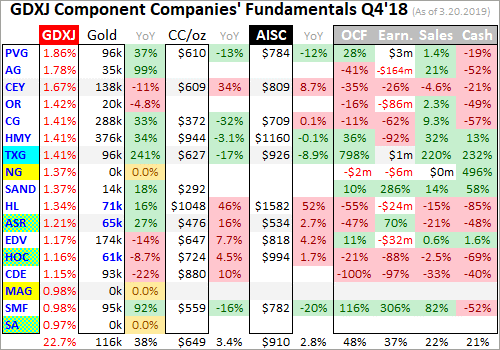
GDXJ’s managers have continued to fine-tune its ranks over this past year, making some good changes. For some inexplicable reason, one of the world’s largest gold miners AngloGold Ashanti was one of this ETF’s top holdings as discussed last quarter. AU was finally kicked out and replaced with a smaller major gold miner Kinross Gold and a mid-tier Buenaventura. Together they now account for 11.7% of GDXJ’s weighting.
Reshuffling at the top makes year-over-year changes less comparable, particularly given KGC’s larger size relative to most of the rest of the GDXJ top 34. Neither it nor BVN were included in GDXJ a year ago, and are new additions since Q3’18 results. Both are sizable GDX components, probably added to GDXJ to keep the weightings down in its smaller Canadian components. 4 other stocks climbed into the top 34.
Torex, Alacer, Hochschild, and Seabridge were already in GDXJ a year ago but weighted below the top 34. GDXJ is largely-but-not-entirely market-cap weighted, so it’s normal for components to rise into or fall out of the top 34 as their stock prices move higher or lower. All the following comparisons between Q4’18 and Q4’17 are across the two slightly-different GDXJ-top-34 sets, not the exact companies shown above.
Production has always been the lifeblood of the gold-mining industry. Gold miners have no control over prevailing gold prices, their product sells for whatever the markets offer. Thus growing production is the only manageable way to boost revenues, leading to amplified gains in operating cash flows and profits. Higher production generates more capital to invest in expanding existing mines and building or buying new ones.
Gold-stock investors have long prized production growth above everything else, as it is inexorably linked to company growth and thus stock-price-appreciation potential. The top 34 GDXJ gold miners excelled in that department, growing their aggregate output by a big 12.8% YoY to 5.1m ounces! That’s really impressive, trouncing both the major gold miners dominating GDX as well as the entire world’s gold-mining industry.
Last week I analyzed the GDX majors’ Q4’18 results, which revealed they are still struggling with serious challenges. The GDX top 34’s total production fell 3.9% YoY when adjusted for a mega-merger. That was worse than total global output slumping 0.9% YoY according to the World Gold Council. So GDXJ’s mostly-mid-tier gold miners really stand out. They are bucking the industry trend with strong production growth.
Again GDXJ’s top 34 components start at the 11th-highest weighting within GDX. Most of the production problems occurred above that threshold, in GDX’s top 10 components which include the world’s largest major gold miners. Their immense average production of 630k ounces in Q4’18 was nearly 4x the 164k average among GDXJ’s top 34! Those GDX top 10 also accounted for a dominant 59.1% of its total weighting.
GDXJ excluding these depleting giants and reallocating their heavy weightings across smaller majors and mid-tier gold miners makes all the difference. The big majors’ waning production and large market caps act as an anchor retarding GDX’s upside. GDXJ doesn’t share that burden, which helped its top 34 show such strong production growth. There’s no reason to own the large majors with their serious challenges.
Also interesting on the GDXJ production front last quarter was silver. This “Junior Gold Miners ETF” also includes major silver miners, both primary and byproduct ones. The GDXJ top 34’s silver mined rocketed 53.8% higher YoY to 31.2m ounces! For comparison the GDX top 34’s total reported output of 28.8m ounces actually slumped 1.5% YoY. The smaller GDXJ mid-tiers are way better than majors at growing their outputs.
The mid-tier gold miners continue to prove all-important production growth is doable off smaller bases. With a handful of mines or less to operate, mid-tiers can focus on expanding them or building a new mine to boost their output beyond depletion. But the majors are increasingly failing to do this with the super-high production bases they operate at. As long as the majors are struggling, it’s prudent to avoid them.
GDXJ investors would be better served if this ETF contained no major gold miners producing over 250k ounces a quarter on average. They still command nearly 1/5th of its weighting, which could be far better reallocated in mid-tiers and juniors. If VanEck kept the major gold miners in GDX where they should be, it could give GDXJ much-better upside potential. That would make this ETF more popular and successful.
In gold mining, production and costs are generally inversely related. Gold-mining costs are largely fixed quarter after quarter, with actual mining requiring about the same levels of infrastructure, equipment, and employees. So the higher production, the more ounces to spread mining’s big fixed costs across. Thus with sharply-higher YoY production in Q4’18, the GDXJ top 34 should’ve seen proportionally-lower costs.
There are two major ways to measure gold-mining costs, classic cash costs per ounce and the superior all-in sustaining costs per ounce. Both are useful metrics. Cash costs are the acid test of gold-miner survivability in lower-gold-price environments, revealing the worst-case gold levels necessary to keep the mines running. All-in sustaining costs show where gold needs to trade to maintain current mining tempos indefinitely.
Cash costs naturally encompass all cash expenses necessary to produce each ounce of gold, including all direct production costs, mine-level administration, smelting, refining, transport, regulatory, royalty, and tax expenses. In Q4’18 these top-34-GDXJ-component gold miners that reported cash costs averaged $698 per ounce. That was up a sharp 10.8% YoY, and considerably worse than the GDX top 34’s $655 average.
Those were the highest GDXJ cash costs seen since at least Q2’16, when I started this research thread. But even $698 is far lower than prevailing gold prices, showing the mid-tier gold miners face no existential threat. And GDXJ’s high cash costs last quarter aren’t righteous anyway, as they were skewed higher by an extreme outlier. One of the new GDXJ companies Buenaventura reported crazy cash costs of $1627 per ounce!
Excluding that wild anomaly, the rest of the GDXJ top 34 averaged cash costs of $662 which was right in line with Q3’18’s $663. They’d be even lower without Sibanye-Stillwater, a troubled South-African major gold miner that saw cash costs soar 30.1% YoY to an ugly $1167. If that too is excluded the overall average falls to $642. So for the most part the mid-tier gold miners’ cash costs remain really low relative to gold.
Way more important than cash costs are the far-superior all-in sustaining costs. They were introduced by the World Gold Council in June 2013 to give investors a much-better understanding of what it really costs to maintain gold mines as ongoing concerns. AISCs include all direct cash costs, but then add on everything else that is necessary to maintain and replenish operations at current gold-production levels.
These additional expenses include exploration for new gold to mine to replace depleting deposits, mine-development and construction expenses, remediation, and mine reclamation. They also include the corporate-level administration expenses necessary to oversee gold mines. All-in sustaining costs are the most-important gold-mining cost metric by far for investors, revealing gold miners’ true operating profitability.
The GDXJ top 34 reporting AISCs averaged $932 per ounce in Q4’18, which was also up a sizable 7.1% YoY. That was also barely the highest seen since at least Q2’16, contradicting the big production growth these miners achieved. But once again this was heavily skewed by extreme outliers, including both BVN and SBGL. Hecla also reported a stunning 52.3% YoY surge in its gold AISCs to a nosebleed $1582 per ounce!
Both BVN and SBGL reported sharply-lower YoY production, helping explain their huge cost surges. HL’s is more temporary, as it expects 2019 gold AISCs to average a still-high-but-much-lower $1250. Without these abnormal situations, the rest of the GDXJ top 34 averaged excellent AISCs of just $863 per ounce. That would be down 0.8% YoY, and is close to the GDX majors’ $837 average also excluding BVN and HL.
Yet even at that skewed artificially-high $932 per ounce, the elite GDXJ gold miners have great potential to enjoy surging profits and hence stock prices. Gold was relatively weak last quarter, averaging $1228 which was 3.8% lower YoY. That implied the mid-tier gold miners as an industry were earning $296 per ounce. That’s still a 24% profit margin, proving Q4’18’s major GDXJ lows weren’t fundamentally righteous.
Gold is faring much better in this almost-over Q1’19, averaging $1303 which is up a big 6.1% quarter-on-quarter. Assuming GDXJ-top-34 AISCs are flat, these elite mid-tier gold miners are earning around $371 per ounce this quarter. That implies enormous 25.3% QoQ profits growth! We won’t know for sure until after Q1’s earnings season, near mid-May. But the mid-tiers’ fundamentals should’ve greatly improved.
Bigger profits driven by higher gold prices are sure to attract investors back to the still-beaten-down gold-stock sector in a big way. The gold miners will stand out even more with earnings growth expected to be scarce in the general stock markets this year. If gold continues marching higher on balance as it ought to, and GDXJ average AISCs retreat as BVN and HL get anomalous costs under control, GDXJ profits will soar.
The GDXJ top 34’s hard accounting results in Q4’18 were mixed, but way better than GDX on all fronts. These elite mid-tier gold miners reported total sales of $7.4b last quarter, up a strong 12.1% YoY. That is right in line with their 12.8% YoY total gold production growth. That huge 53.8% YoY surge in their silver output helped offset the 3.8% YoY decline in average gold prices. The mid-tier gold miners’ revenues are strong.
Compare that to the GDX top 34, which saw sales plunge 10.3% YoY in Q4 due to 3.9%-lower merger-adjusted gold output. Those strong GDXJ-top-34 revenues kept operating-cash-flow generation solid, totaling $2.2b which was down 9.2% YoY. That again crushed the majors in the GDX top 34, which saw OCFs plummet 30.4% YoY. The divergence between how mid-tiers and majors are faring these days is gaping.
The elite GDXJ mid-tier gold miners also invested in growing their production, so their collective total cash on hand slid 14.3% YoY to $5.9b. The GDX majors saw a similar 14.6% YoY decline in their cash, yet they certainly didn’t spend enough to offset their depleting mines. The only real blemish on the GDXJ top 34’s Q4 results came in hard GAAP profits. Their aggregate bottom line collapsed to a $732m loss last quarter!
That was far worse than Q4’17’s $26m loss. Much of this was due to big non-cash impairment charges, writedowns of the carrying value of gold mines and deposits due to lower gold prices and forecasts. If gold miners expect lower gold prices going forward, they have to flush the resulting expected economic losses through current-quarter results when those impairments are perceived. That hammered overall results.
Honestly the Q4’18 impairments seemed pretty unnecessary, with average gold prices merely down 3.8% YoY. 2018’s full-year average gold price actually rose 0.8% YoY. Major impairments usually happen in years gold plunges sharply, like 2013’s brutal 27.9% plummeting. Something like that really changes the economic assumptions underlying gold mines. But gold only slumped 1.6% last year, which is utterly trivial.
Some of the bigger impairment charges came from First Majestic Silver and Osisko Gold, which wrote off $168m and $166m. This primary silver miner and gold-royalty company aren’t even mid-tier gold miners. And the perpetually-troubled South African majors Gold Fields and Sibanye-Stillwater which have long tainted GDXJ reported big half-year losses implying $169m and $98m in Q4. These alone total $601m of losses.
That accounted for nearly 5/6ths of the GDXJ top 34’s total GAAP losses last quarter. While many of the elite mid-tier gold miners reported small losses, the great majority of the surge in losses came from a handful of stocks. Overall the GDXJ GAAP profits looked relatively decent compared to the majors. GDX’s top 34 reported a staggering $6.0b in accounting losses in Q4’18! The mid-tiers are thrashing the majors.
GDXJ’s mostly-mid-tier component list of great gold miners is really faring well, especially compared to the struggling large gold miners. Investors looking to ride this gold-stock bull should avoid the world’s biggest gold producers and instead deploy their capital in the mid-tier realm. The best gains will be won in individual smaller gold miners with superior fundamentals, plenty of which are included within GDXJ.
Despite being the world’s leading gold-stock ETF, GDX needs to be avoided. The major gold miners that dominate its weightings are struggling too much fundamentally, unable to grow their production. Capital will instead flow into the mid-tiers, juniors, and maybe a few smaller majors still able to boost their output and thus earnings going forward. None of this is new, but the major and mid-tier disconnect continues to worsen.
Again back in essentially the first half of 2016, GDXJ skyrocketed 202.5% higher on a 29.9% gold upleg in roughly the same span! While GDX somewhat kept pace then at +151.2%, it is lagging GDXJ more and more as its weightings are more concentrated in stagnant gold mega-miners. The recent big mergers are going to worsen that investor-hostile trend. Investors should buy better individual gold stocks, or GDXJ.
One of my core missions at Zeal is relentlessly studying the gold-stock world to uncover the stocks with superior fundamentals and upside potential. The trading books in both our popular weekly and monthly newsletters are currently full of these better gold and silver miners. Mostly added in recent months as gold stocks recovered from deep lows, our unrealized gains are already running as high as 74% this week!
If you want to multiply your capital in the markets, you have to stay informed. Our newsletters are a great way, easy to read and affordable. They draw on my vast experience, knowledge, wisdom, and ongoing research to explain what’s going on in the markets, why, and how to trade them with specific stocks. As of Q4 we’ve recommended and realized 1076 newsletter stock trades since 2001, averaging annualized realized gains of +16.1%! That’s nearly double the long-term stock-market average. Subscribe today for just $12 per issue!
The bottom line is the mid-tier gold miners are thriving fundamentally. They are still rapidly growing their production while majors suffer sharp output declines. The mid-tiers are holding the line on costs, which portends strong leveraged profits growth as gold continues grinding higher on balance. The performance gap between the smaller mid-tier and junior gold miners and larger major ones is big and still mounting.
Investors and speculators really need to pay attention to this intra-sector disconnect. Gold and its miners’ stocks should power far higher in coming years as the lofty general stock markets roll over. But the vast majority of the gains will be concentrated in growing gold miners, not shrinking ones. This means the mid-tier and junior gold miners will far outperform the majors. The smaller miners have superior fundamentals.
Adam Hamilton, CPA
March 25, 2019
Copyright 2000 – 2019 Zeal LLC (www.ZealLLC.com)
Defense Metals (TSV-V: DEFN) / (OTCQB: DFMTF) is a great name. The Company is defending against Chinese dominance of Rare Earth Elements (“REEs“), and Defense Departments require select REEs to defend their countries! Several REEs are very difficult or impossible to replace in critical applications, yet enable products essential to modern civilization. Any company outside of China that can reliably produce a few key REEs will have a license to print money. This week, SGS Canada provided select head assay results from a 30-tonne bulk sample. Four REE assays were reported in this press release {see chart below}. Using the price/kg of each metal, the in-situ value is ~US$ 535/t. That’s equivalent to ~ 0.41 troy ounces Gold or ~12.8 g/t Gold.
In the following interview of CEO Max Sali, readers will learn more about REEs and about Light Rare Earth Elements (“LREEs“), which REEs are in highest demand, and for which applications. Spoiler alert, Neodymium & Praseodymium are in the top 4 or 5. I asked Max why his team believes that its deposit of LREEs might be economically viable given the odds stacked against any deposit becoming a mine. To finish off, we discussed some early-stage uranium assets the Company picked up in the famous Athabasca basin. {Corporate Presentation}
Please give readers the latest snapshot of Defense Metals.
Sure. Defense Metals (TSV-V: DEFN) / (OTCQB: DFMTF) is focused on sourcing, exploring and developing rare earth & uranium properties in Canada. Our flagship project is the Wicheeda rare earth deposit. NOTE: {here’s a good, brand new article by Rick Mills on Defense Metals}
The Wicheeda deposit (6 mineral claims, 1,780 hectares) is 80 km northwest of Prince George, in British Columbia, (“BC“) Canada, and contains potentially exploitable concentrations of Rare Earth Elements. The deposit was explored in the 1970’s & 1980’s, but received little further attention until 2008 when it was drilled by Spectrum Mining Corp. They reported an Inferred resource of 11.3 million tonnes. More recently, SGS Canada provided us with an important update on the deposit. Four REE assays from a 30 tonne bulk sample we sent them earlier this year showed significant concentrations of both Neodymium & Praseodymium.
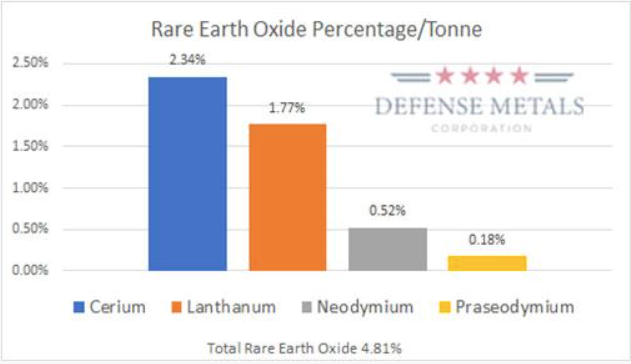
The Wicheeda deposit is a very exciting project because we can potentially get it into production fairly quickly, especially given nearby infrastructure (roads, rail, water, power, labor, mining equipment & services). A favorable mineralogy & Light Rare Earth Element (“LREE“) distribution make the Wicheeda deposit highly attractive. Some impurities can be removed through electromagnetic separation done on site. The press release we put out this week was important because it gave us a new understanding of the deposit, {see graph below}. Total Rare Earth Oxide (“TREO“) was 4.81%, which we feel is attractive.
Wicheeda is ideally suited for open pit mining and conventional flotation to produce a REE-enriched oxide concentrate. In addition to Lanthanum, Cerium & Neodymium, we also have Praseodymium. Importantly, the deposit is open in most directions and outcrops at surface, meaning a low strip ratio and the potential for expansion. Encouraging bench-scale tests have been done, giving our team the goal of a 60%+ concentrate.
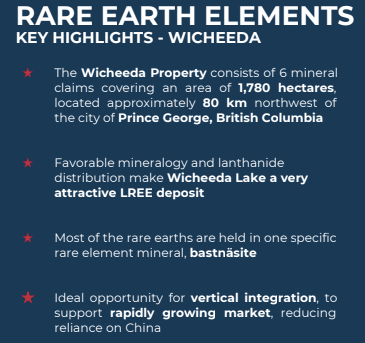
Although the main focus is our rare earth deposit, we also have 2 prospective uranium properties (5 claims blocks), in the heart of the eastern Athabasca basin near Denison Mines and IsoEnergy. Both of those companies are spending millions on drilling this year. IsoEnergy has made a new high-grade discovery 5-10 km from one of our properties.
Which rare earths are in the deposit? Which rare earths in your deposit are most valuable?
The following REEs can be found, Lanthanium, Cerium, Praseodymium, Neodymium, Samarium, Europium, Gadolinium, Yttrium & Dysprosium. There are also trace amounts of a few others. Neodymium & Praseodymium are the most valuable in the suite.
How have the prices of your most important rare earth metals trended over the past few years?
Neodymium and Praseodymium are the most important rare earth metals we have identified at the Wicheeda deposit. Neodymium (Nd) & Praseodymium (Pr) are the two rare earth elements which form the majority of rare earth permanent magnets. Below are 5-yr price charts from Kitco. The most recent prices of US$62.0 per kg for Neodymium Oxide and US$78.4 per kg for Praseodymium Oxide are down from recent highs, but up 35%-40% from mid-2016 lows.
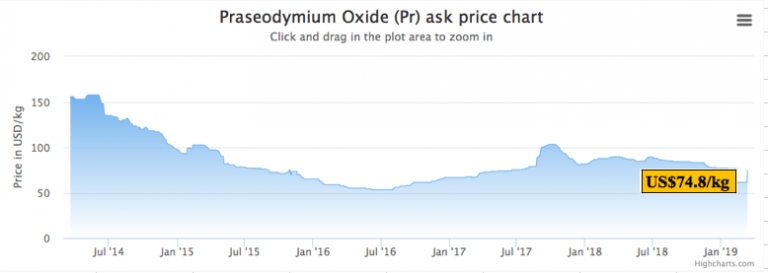
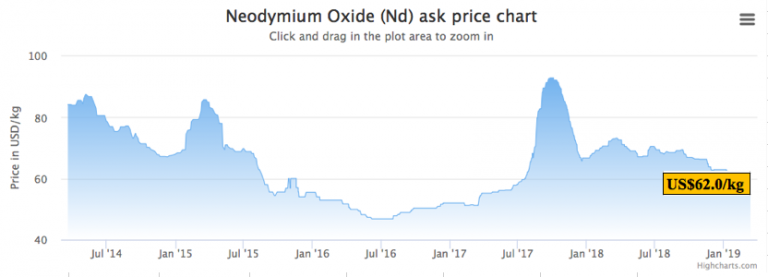
Does management have any indicative information on metallurgy, the potential recoveries of individual metals?
Bench-scale flotation and hydrometallurgical test work was done on Wicheeda deposit drill cores at a SGS Lakefield lab during 2010/2011. SGS successfully developed a flotation flow sheet that recovered 83% of the rare earth oxide (REO) and produced a concentrate grading 42% REO. Subsequent hydrometallurgical testing in 2012 on a 2-kg sample of the concentrate grading 39.7% TREO (total REO) produced an upgraded and purified precipitate containing 71% TREO through a process of pre-leaching and roasting.
SGS Canada is well into the planned work program which includes chemical & mineralogical characterization, grindability & laboratory flotation testing on a 200-kg subsample (of the 30 tonne surface bulk sample). The objectives are to validate the process and confirm that conditions of the previously established 2010/2011 bench-scale drill core flotation test work can be upscaled to the current bulk sample; in addition to further optimization of the process flowsheet.
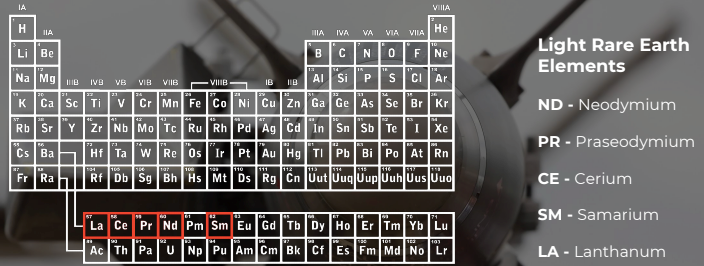
What will management learn from SGS Canada’s work?
As mentioned, Defense Metals delivered a 30 tonne surface bulk sample from the Wicheeda deposit to SGS Canada. SGS is conducting a multi-phase program of bench-scale metallurgical test work preparatory to commissioning larger scale flotation pilot plant testing. Larger scale pilot plant production is expected to validate bench-scale metallurgy and produce LREE product samples for potential off-take partners. The ultimate goal of the test work is to finalize the process flowsheet prior to the commissioning of larger-scale pilot plant testing. SGS has agreed to give us regular updates on its progress. In addition, Defense Metals plans to re-assay the ‘pulps’ used to produce a new 43-101 Inferred resource estimate. A Preliminary Economic Assessment (“PEA“) will follow.
Defense Metals also has uranium assets in the eastern Athabasca basin, please describe those properties.
Yes, these properties are early stage, and total nearly 10,000 hectares. We have people reviewing the historical work done on the properties, which actually comprise 5 claim blocks. We will likely do some airborne electromagnetic survey work, but to be honest, the eastern Athabasca basin is a hotbed of activity, so we may just allow our neighbors to drill around us and see what they find. Our holding costs on the properties are extremely low.
We are very pleased to have Dale Wallster join our technical advisory board. Dale is a geologist & prospector with 35 years’ experience in North American mineral deposit exploration, with a focus on the targeting & discovery of unconformity-related uranium deposits. He was President & Founder of Roughrider Uranium Corp., a company acquired by Hathor Exploration in 2006 for its strategically located uranium properties in the Athabasca Basin. Dale and his team are widely credited for the discovery of Hathor’s Roughrider deposit. In January 2012, Hathor became a wholly-owned subsidiary of Rio Tinto as part of a C$650 million acquisition.
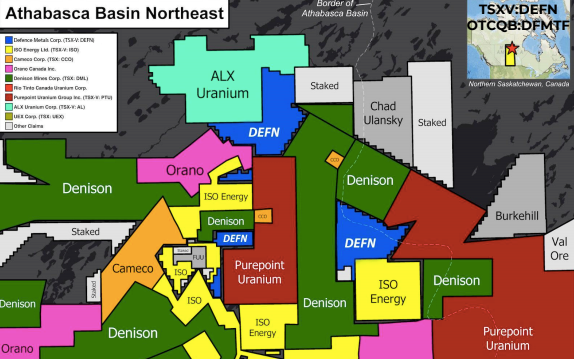
Why should readers consider buying shares of Defense Metals?
Defense Metals (TSV-V: DEFN) / (OTCQB: DFMTF) offers an attractive, early-stage way to play the REE market. Our LREE deposit appears to be sizable and is open in multiple directions. It contains potentially economic amounts of select rare earth metals. At least 2 of the REEs, Neodymium (Nd) & Praseodymium (Pr) are quite valuable and in high demand for use in permanent magnets. There are indications that the metallurgy of the Wicheeda deposit is favorable and considerable testing is being done on metallurgy.
If the Company receives additional positive reports from SGS Canada, that could be a catalyst for our share price, as it would provide support for the thesis that we can put the project into initial production fairly quickly. While still early-stage, the Wicheeda deposit has had ample historical work done on it dating back decades, and is undergoing significant, wide-ranging testing right now. If we can advance this project in 2019 the way that we think we can, our current market cap of C$5.1 M = US$3.8 M (23.75 M shares outstanding) could prove to be an attractive entry point.
Thank you Max, that was very interesting, congratulations on the new assay results.
Disclosures: The content of this interview is for information only. Readers fully understand and agree that nothing contained herein, written by Peter Epstein of Epstein Research [ER], (together, [ER]) about Defense Metals, including but not limited to, commentary, opinions, views, assumptions, reported facts, calculations, etc. is not to be considered implicit or explicit investment advice. Nothing contained herein is a recommendation or solicitation to buy or sell any security. [ER] is not responsible under any circumstances for investment actions taken by the reader. [ER] has never been, and is not currently, a registered or licensed financial advisor or broker/dealer, investment advisor, stockbroker, trader, money manager, compliance or legal officer, and does not perform market making activities. [ER] is not directly employed by any company, group, organization, party or person. The shares of Defense Metals are highly speculative, not suitable for all investors. Readers understand and agree that investments in small cap stocks can result in a 100% loss of invested funds. It is assumed and agreed upon by readers that they will consult with their own licensed or registered financial advisors before making any investment decisions.
At the time this interview was posted, Peter Epstein owned shares in Defense Metals and it was an advertiser on [ER]. Readers understand and agree that they must conduct their own due diligence above and beyond reading this article. While the author believes he’s diligent in screening out companies that, for any reasons whatsoever, are unattractive investment opportunities, he cannot guarantee that his efforts will (or have been) successful. [ER] is not responsible for any perceived, or actual, errors including, but not limited to, commentary, opinions, views, assumptions, reported facts & financial calculations, or for the completeness of this article or future content. [ER] is not expected or required to subsequently follow or cover events & news, or write about any particular company or topic. [ER] is not an expert in any company, industry sector or investment topic. [ER] may buy or sell shares in Defense Metals and other advertising companies at any time.
1. The latest U.S. central bank announcement was a win-win for gold.
2. If the Fed surprised analysts and hiked rates, the stock market probably crashes, and gold stocks rally strongly.
3. As expected, the Fed did nothing and gold stocks outperformed.
4. It’s a clear win-win situation for gold bugs around the world.
5. I’m adamant that the U.S. stock market would already look somewhat akin to the 1929 bear market if the Fed had not killed its “ QT on auto pilot ” and “ rates are years away from being normalized ” statements.
6. In contrast, there was/is no QE in China or India. In addition, interest rates are twice as high in China as America, and three times as high in India.
7. The bottom line: Stock markets are propelled significantly higher or lower by central bank policy. Chinese and Indian central banks have vastly more long-term ability to “ juice ” their stock markets higher than the Fed does.
8. This leaves aside the “minor detail” that there are three billion citizens in Chindia. The Chindian population absolutely dwarfs the U.S. population. The citizens are gold-oriented workaholics growing their economy at 6%-7% annually.
9. Most incredible of all: This growth is happening against the background of a quasi-communist government in China and a mafia-like government in India.
10. What happens as those governments transition to the more business-friendly type of government that exists in America? Answer: Vastly more wealth and vastly more demand for gold!
11. Please click here now: [ https://gracelandjuniors.com/wordpress/wp-content/uploads/2019/03/2019mar19bankgold1.png ] The almost universal enthusiasm for gold amongst elite bank analysts around the world right now is highly impressive.
12. Their support for gold on this $70/ounce pullback has been unwavering and Commerzbank analysts appear to be predicting that a surge to the $1700 price zone is imminent!
13. These heavyweight bank analysts influence the decision-making process of institutional money managers. They also affect mainstream financial media. Gold is gaining news coverage as an asset class to be respected.
14. Please click here now: [ https://gracelandjuniors.com/wordpress/wp-content/uploads/2019/03/2019mar19bankgold2.png ] Bank America’s elite gold market analysts note the steady progress being made with global de-dollarization.
15. The bulk of the action taking place on that front involves fresh and steady allocation to gold by central banks. India’s savvy central bank was a massive buyer near the 2009 lows and now it appears to be committing to a monthly buy program.
16. For gold price forecasting, retail investor sentiment is becoming less important than it was in the past. What matters now is central bank sentiment and bank analyst sentiment. The phrase that describes that sentiment best is: Solid as a golden rock!
17. Please click here now: [ https://gracelandjuniors.com/wordpress/wp-content/uploads/2019/03/2019mar19gold1.png ] Double-click to enlarge. As relentless Chindian demand growth, limited mine supply growth, and central bank de-dollarization all take the centre stage of price discovery in the eyes of the elite bank analysts, negative technical formations like this H&S top will continue be voided, and gold’s uptrend will continue.
18. As gold pulled back to the $1280 I suggested that could be the new floor for the price. The powerful rally in the rupee taking place against the dollar now is triggering a surge in Indian dealer demand. In turn, that’s causing powerful commercial bank traders to cover short positions.
19. Trump is working hard to reverse the damage to global stock markets that his tariffs caused and the Fed has become highly supportive with its statements and actions. I see no reason for that to change with this week’s FOMC policy announcement and Trump is going to intensify his efforts to get a trade deal that is friendly to stock markets.
20. I’m “ long and strong ” the U.S. stock market, the Indian stock market, the Chinese stock market, and the entire precious metals sector… with a wide array of investment vehicles.
21. Please click here now: [ https://gracelandjuniors.com/wordpress/wp-content/uploads/2019/03/2019mar19gdx.png ] Double-click to enlarge this GDX daily chart. While I’m long DUST-NYSE at my [http://www.guswinger.com/ ] swing trade service, that’s a mechanical short-term system designed to produce solid profits during wild volatility events like the Fed meet.
22. In the big picture, volume is soft on down days for most gold stocks. Volume is rising as the price rises. That’s bullish. Most importantly, the GDX price action can be themed as… “ solid” . As gold rallied to $1350, I predicted that many individual miners would keep rallying as gold pulled back.
23. A big feature of the current $70/ounce gold price consolidation has been the continued rally of many miners . A rise in gold to the $1520 area would turn these miners into cash cows, and a further rally to Commerzbank’s $1700 predicted price should cause an institutional feeding frenzy!
24. Gold is steadily reclaiming its title as “ ultimate asset ”, which means it rises in good times and bad. If global stock markets rise, gold rises. If global stock markets crash, gold rises. Owning gold is now the “ ultimate no-brainer ” tactic for central banks and heavyweight bank analysts. Let’s hope that sentiment envelops 100% of the Western gold community… right here, right now!
Special Offer For Website Readers: Please send me an Email to freereports4@gracelandupdates.com and I’ll send you my free “Golden Seniors!” report. I highlight key senior gold stocks with incredible upside potential that are trading at under $10/share. It’s essentially an opportunity to buy senior producers at junior prices! I include key buy and sell zones for each great stock.
Thanks!!
Cheers
Stewart Thomson
Graceland Updates
mail:
stewart@gracelandupdates.com
stewart@gracelandjuniors.com
Stewart Thomson is a retired Merrill Lynch broker. Stewart writes the Graceland Updates daily between 4am-7am. They are sent out around 8am-9am. The newsletter is attractively priced and the format is a unique numbered point form. Giving clarity of each point and saving valuable reading time.
Risks, Disclaimers, Legal
Stewart Thomson is no longer an investment advisor. The information provided by Stewart and Graceland Updates is for general information purposes only. Before taking any action on any investment, it is imperative that you consult with multiple properly licensed, experienced and qualified investment advisors and get numerous opinions before taking any action. Your minimum risk on any investment in the world is: 100% loss of all your money. You may be taking or preparing to take leveraged positions in investments and not know it, exposing yourself to unlimited risks. This is highly concerning if you are an investor in any derivatives products. There is an approx $700 trillion OTC Derivatives Iceberg with a tiny portion written off officially. The bottom line:
Are You Prepared?
In recent weeks we noted the bullish outlook for the stock market.
Friday the S&P 500 as well as ACWX (global equity ETF ex US stocks) closed above resistance and made higher highs.
Not surprisingly, as US and global equities have avoided a bear market (for the time being), precious metals have weakened. It’s not a surprise that as Gold failed to breakout both the S&P 500 and global equities (ACWX) held their 200-day moving averages and then made a higher high.
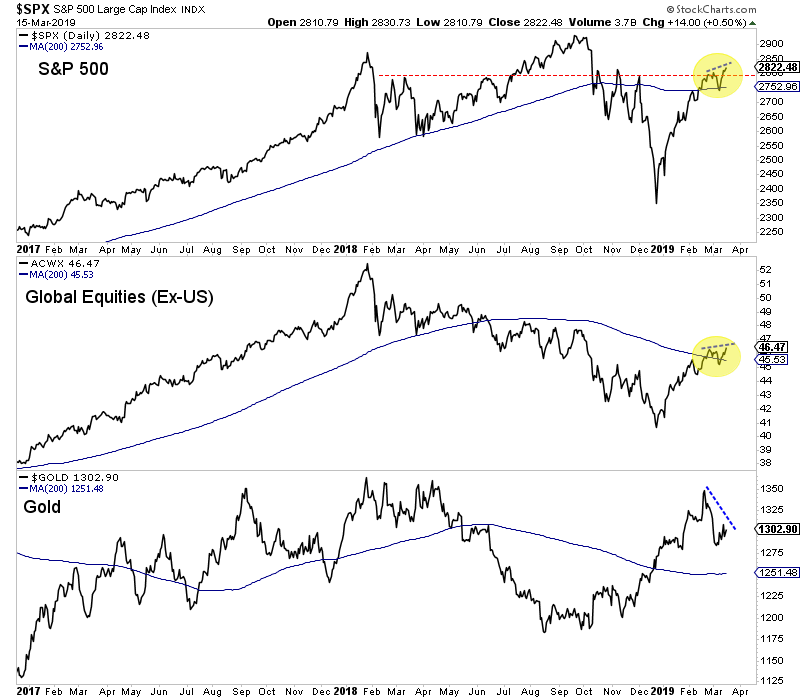
The very recent underperformance in Gold and precious metals is better illustrated in the ratio charts below.
Gold against stocks made a very strong move in the fourth quarter but instead of digesting or consolidating that move, the ratios have steadily declined. The same could be said for the GDX ratios as they have formed rounding tops.
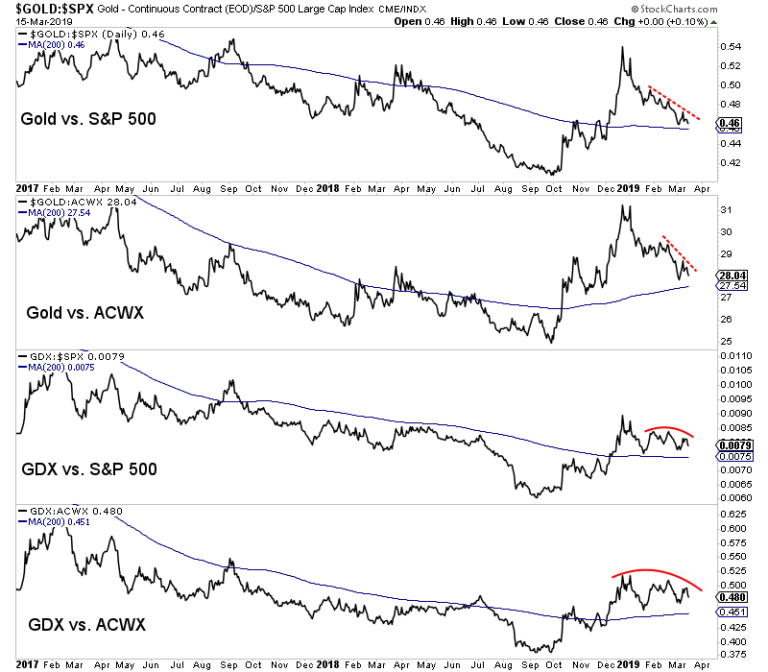
The implication is obviously not favorable for precious metals because outperformance of the stock market is a necessity for a bull market and especially so, given the current context.
That being said, one positive for the precious metals complex is the miners are outperforming the metals. Last week the GDX to Gold ratio hit a seven and a half month high.
Another positive is breadth has not deteriorated yet. The GDX advance decline line is only a tiny bit off the recent high and 73% of the HUI and 65% of GDXJ are above the 200-day moving averages.
Ultimately and to continue to beat the dead horse, a bull market in precious metals cannot begin without outperformance against the stock market. That will likely coincide with the Fed moving from pause mode to rate cuts.
The immediate outlook is bullish for stocks and therefore do not expect Gold to breakout or begin a bull market. It’s unclear if renewed stock market strength will lead to a larger topping pattern or if its an indication that growth will stabilize for the rest of 2019.
Regardless, until Gold outperforms stocks and the Fed is ready to cut, we are focused on the companies that can perform without a rising Gold price. To learn which juniors have 3x to 5x potential over the next 12 to 18 months, consider learning more about our premium service.
The major gold miners are grinding higher in a solid upleg, fueling growing interest in this small contrarian sector. They’ve mostly finished reporting their fourth-quarter results, revealing how they are really faring fundamentally. Collectively the world’s biggest gold miners continue to face serious challenges, which often stem from declining production. That makes stock picking more important than ever for investment success.
Four times a year publicly-traded companies release treasure troves of valuable information in the form of quarterly reports. Required by the U.S. Securities and Exchange Commission, these 10-Qs and 10-Ks contain the best fundamental data available to traders. They dispel all the sentiment distortions inevitably surrounding prevailing stock-price levels, revealing corporations’ underlying hard fundamental realities.
While 10-Qs with filing deadlines of 40 days after quarter-ends are required for normal quarters, 10-K annual reports are instead mandated after quarters ending fiscal years. Most gold miners logically run their accounting on calendar years, so they issue 10-Ks after Q4s. Since these annual reports are larger and must be audited by independent CPAs, their filing deadlines are extended to 60 days after quarter-ends.
The definitive list of major gold-mining stocks to analyze comes from the world’s most-popular gold-stock investment vehicle, the GDX VanEck Vectors Gold Miners ETF. Launched way back in May 2006, it has an insurmountable first-mover lead. GDX’s net assets running $10.6b this week were a staggering 47.1x larger than the next-biggest 1x-long major-gold-miners ETF! GDX is effectively this sector’s blue-chip index.
It currently includes 45 component stocks, which are weighted in proportion to their market capitalizations. This list is dominated by the world’s largest gold miners, and their collective importance to this industry cannot be overstated. Every quarter I dive into the latest operating and financial results from GDX’s top 34 companies. That’s simply an arbitrary number that fits neatly into the tables below, but a commanding sample.
As of this week these elite gold miners accounted for fully 94.1% of GDX’s total weighting. Last quarter they combined to mine 300.8 metric tons of gold. That was 35.2% of the aggregate world total in Q4’18 according to the World Gold Council, which publishes comprehensive global gold supply-and-demand data quarterly. So for anyone deploying capital in gold or its miners’ stocks, watching GDX miners is imperative.
The largest primary gold miners dominating GDX’s ranks are scattered around the world. 21 of the top 34 mainly trade in US stock markets, 6 in Australia, 5 in Canada, and 1 each in China and the United Kingdom. GDX’s geopolitical diversity is good for investors, but makes it more difficult to analyze and compare the biggest gold miners’ results. Financial-reporting requirements really vary from country to country.
In Australia, South Africa, and the UK, companies report in half-year increments instead of quarterly. The big gold miners often publish quarterly updates, but their data is limited. In cases where half-year data is all that is made available, I split it in half for a Q4 approximation. While Canada has quarterly reporting, the deadlines are looser than in the States. Some Canadian gold miners drag their feet in getting results out.
While it is challenging bringing all the quarterly data together for the diverse GDX-top-34 gold miners, analyzing it in the aggregate to see how they are doing is essential. So each quarter I wade through all available operational and financial reports and dump the data into a big spreadsheet for analysis. The highlights make it into these tables. Blank fields mean a company hadn’t reported that data as of this Wednesday.
The first couple columns of these tables show each GDX component’s symbol and weighting within this ETF as of this week. While most of these stocks trade on U.S. exchanges, some symbols are listings from companies’ primary foreign stock exchanges. That’s followed by each gold miner’s Q4’18 production in ounces, which is mostly in pure-gold terms. That excludes byproduct metals often present in gold ore.
Those are usually silver and base metals like copper, which are valuable. They are sold to offset some of the considerable expenses of gold mining, lowering per-ounce costs and thus raising overall profitability. In cases where companies didn’t separate out gold and lumped all production into gold-equivalent ounces, those GEOs are included instead. Then production’s absolute year-over-year change from Q4’17 is shown.
Next comes gold miners’ most-important fundamental data for investors, cash costs and all-in sustaining costs per ounce mined. The latter directly drives profitability which ultimately determines stock prices. These key costs are also followed by YoY changes. Last but not least the annual changes are shown in operating cash flows generated, hard GAAP earnings, revenues, and cash on hand with a couple exceptions.
Percentage changes aren’t relevant or meaningful if data shifted from positive to negative or vice versa, or if derived from two negative numbers. So in those cases I included raw underlying data rather than weird or misleading percentage changes. Companies with symbols highlighted in light-blue have newly climbed into the elite ranks of GDX’s top 34 over this past year. This entire dataset together is quite valuable.
It offers a fantastic high-level read on how the major gold miners are faring fundamentally as an industry. Unfortunately they were generally struggling on multiple fronts in Q4’18. The more quarterly reports I read and data I gathered, the more apparent it became that many if not most of the world’s biggest gold miners continue to face serious challenges. That makes GDX itself way less attractive to gold-stock investors.
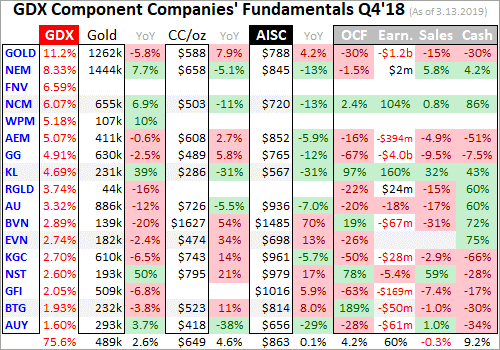
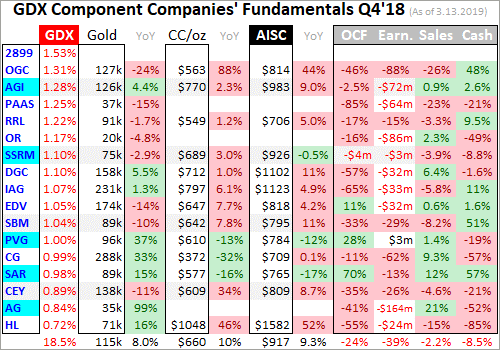
GDX’s holdings grew much more concentrated over this past year, with the top 34’s total weighting rising from 90.5% in Q4’17 to 94.1% in Q4’18. That is partially due to increased merger-and-acquisition activity driven by big gold miners trying to replace depleting production. For years many have proven unable to replenish mined gold organically, leaving buying other companies the only option to maintain mining tempos.
Production has always been the lifeblood of the gold-mining industry. Gold miners have no control over prevailing gold prices, their product sells for whatever the markets offer. Thus growing production is the only manageable way to boost revenues, leading to amplified gains in operating cash flows and profits. Higher production generates more capital to invest in expanding existing mines and building or buying new ones.
Gold-stock investors have long prized production growth above everything else, as it is inexorably linked to company growth and thus stock-price-appreciation potential. But for some years now the major gold miners have been struggling to grow production. Large economically-viable gold deposits are getting increasingly harder to find and more expensive to exploit, with the low-hanging fruit long since picked.
More and more gold-industry experts believe peak gold is nearing, after which global mine production will start declining. For many years now new deposit discoveries and mine builds have failed to keep pace with depletion at existing mines. So production growth is slowing. According to the World Gold Council’s latest fundamental data, global mine production only edged 0.8% higher in 2018 compared to 5.3% in 2013!
GDX’s major gold miners are the biggest in the world, with access to many billions of dollars of capital to expand their operations. Yet even with those vast resources by his sector’s standards, the top 34 have still failed to grow their production. In Q4’18 they collectively produced 9.7m ounces of gold, plunging a colossal 7.5% YoY from Q4’17’s 10.5m! That is shockingly bad, and the root of the major gold miners’ problems.
Total world gold production per the WGC merely slipped 0.9% YoY last quarter. Incidentally that was just the second YoY quarterly decline in the past 32 quarters, adding more fuel to peak-gold theories. Across all of them growth averaged 2.5% YoY. Seeing the top 34 GDX gold miners’ production plunge at 8.3x the world rate in Q4’18 is very concerning. Many major gold miners are stagnating, retarding GDX’s potential.
Just over half of GDX’s top 34 gold miners, fully 18 of them, suffered average production declines of 8.9% YoY! The worst in terms of impact came from GDX’s largest component Barrick Gold. GOLD’s gold mined fell 5.8% YoY in Q4’18, representing 1/10th of the total drop among the GDX top 34. Barrick is so desperate to buy production to offset its serious depletion that it recently purchased major gold miner Randgold.
That deal completed on January 1st, 2019, so GOLD’s Q4’18 results don’t yet reflect it. Randgold mined 374.6k ounces last quarter, which was actually up an impressive 9.9% YoY. That helps explain some of the big production drop among the GDX top 34. Randgold’s production was included in the GDX top 34 in Q4’17, but of course its stock no longer exists this week when I downloaded GDX’s current component list.
Adding Randgold’s Q4’18 production in cuts the GDX top 34’s production decline to 3.9% YoY. Going the other way and instead removing it from Q4’17’s total leaves the top 34’s mined gold down 4.4% YoY. But that’s still much worse than that overall 0.9% YoY decline in global gold mine production last quarter. As I explained in depth in a mid-February essay, gold-stock mega-mergers won’t solve this depletion problem.
Before Q4’18, Randgold suffered 4 quarters in a row of falling production averaging declines of 7.4% YoY. Barrick’s quarterly production has fallen for 6 quarters in a row, averaging hefty 13.4% YoY drops! Merging depleting major gold miners together doesn’t magically boost their collective production. It just masks production declines for a single year, the first 4 quarters comparing post-merger results with pre-merger ones.
Once those great cross-merger YoY comparisons pass, the relentless depletion in both companies’ gold mines will quickly become apparent again. The larger any gold miner, the harder it is to grow and even just maintain production levels. Because exploration budgets largely collapsed since 2013 when gold plunged and crushed gold stocks, the global pipeline of bigger economic gold deposits to mine has mostly dried up.
GDX’s top-two components have always been Barrick Gold and Newmont Gold. This week together they accounted for 19.5% of its total weighting and a whopping 28.0% of the top 34’s total Q4’18 gold mined! Had Barrick’s and Randgold’s merger been consummated in Q4, GOLD’s production would’ve soared over 1.8m ounces. Newmont didn’t want Barrick to surpass it, so in January it announced it was buying Goldcorp.
GG produced 630k ounces of gold in Q4, which will be added onto Newmont’s production going forward once this deal is done. Had Newmont and Goldcorp been together in Q4’18, this gold-mining behemoth would’ve produced nearly 2.1m ounces! Those levels are staggering, and will really increase these two mega-miners’ dominance over this sector and GDX. These mergers’ pro-forma impact on GDX is massive.
Using Q4’s numbers, Newmont and Barrick would’ve accounted for a colossal 38.8% of the GDX top 34’s entire gold mined including Randgold. Their collective weighting in this leading gold-stock ETF would shoot over a quarter. So the overall GDX future performance will be more dominated by Newmont and Barrick than ever before. If they can’t grow production from such stratospheric levels, they’ll retard GDX’s upside.
With gold deposits increasingly harder to discover, and taking even longer to get permitted and brought into production at ever-higher costs, the biggest gold miners are going to find it impossible to even maintain their outputs. Any production growth is going to come from smaller gold miners, and their stocks will soar to reflect it. Unfortunately the impact on GDX will be muted, since its weightings are tyrannized by the giants.
Kirkland Lake Gold has been one of the best-performing gold stocks over this past year. In 2018 its stock rocketed 69.9% higher as GDX fell 9.3%! The reason investors flocked to KL is it has rapidly grown its gold output, which soared 38.8% YoY in Q4’18. That greatly boosted its sales, operating cash flows, and profits. More gold produced spreads out the big fixed costs of mining across more ounces, amplifying earnings.
No matter how awesome KL’s management has proved, such production growth was only possible from a relatively-low base. KL produced 167k ounces of gold in Q4’17, compared with around 8x that from each Newmont and Barrick. The biggest gains in gold-stock prices won’t come from super-major-dominated GDX, but from smaller mid-tier gold miners. Investors will continue to prize and richly reward production growth.
Peak gold is likely bearish for the largest gold miners that drive GDX. Capital inflows from investors will wane along with their shrinking production. But lower gold mined supply on balance going forward is wildly bullish for the mid-tier and junior gold miners growing their production! The resulting higher gold prices will catapult their profits and thus stock prices far higher, attracting investors fleeing the struggling majors.
The only way to reap these massive gains is directly investing in the best individual gold miners. Their fundamentals are far superior to their sector’s as a whole. While buying GDX is easy, the lion’s share of that capital is funneled into the major gold miners with slowing production. Their underperformance will dilute away any outperformance among mid-tier miners in this ETF, leading to way-inferior overall gains.
Given the sharply-lower gold production by the GDX top 34 in Q4’18, per-ounce mining costs should’ve risen proportionally. Gold-mining costs are largely fixed quarter after quarter, with actual mining requiring the same levels of infrastructure, equipment, and employees. So the lower production, the fewer ounces to spread mining’s big fixed costs across. These elite gold miners indeed reported higher costs last quarter.
There are two major ways to measure gold-mining costs, classic cash costs per ounce and the superior all-in sustaining costs per ounce. Both are useful metrics. Cash costs are the acid test of gold-miner survivability in lower-gold-price environments, revealing the worst-case gold levels necessary to keep the mines running. All-in sustaining costs show where gold needs to trade to maintain current mining tempos indefinitely.
Cash costs naturally encompass all cash expenses necessary to produce each ounce of gold, including all direct production costs, mine-level administration, smelting, refining, transport, regulatory, royalty, and tax expenses. In Q4’18 these top 34 GDX-component gold miners that reported cash costs averaged $655 per ounce. That was up a sharp 9.1% YoY, among the highest quarterly cash costs seen in years.
That still shows the major gold miners face no existential threat as long as gold stays over $650, which is about half current levels. And Q4’s cash costs are artificially high due to two anomalies. Buenaventura and Hecla both reported cash costs rocketing to extremes of $1627 and $1048! Excluding these outliers, the rest of the GDX top 34 averaged cash costs of $598, which was right in line with Q4’17’s overall $600 read.
Way more important than cash costs are the far-superior all-in sustaining costs. They were introduced by the World Gold Council in June 2013 to give investors a much-better understanding of what it really costs to maintain gold mines as ongoing concerns. AISCs include all direct cash costs, but then add on everything else that is necessary to maintain and replenish operations at current gold-production levels.
These additional expenses include exploration for new gold to mine to replace depleting deposits, mine-development and construction expenses, remediation, and mine reclamation. They also include the corporate-level administration expenses necessary to oversee gold mines. All-in sustaining costs are the most-important gold-mining cost metric by far for investors, revealing gold miners’ true operating profitability.
The GDX top 34 gold miners reported average AISCs of $889 in Q4’18, up 3.6% YoY. That is inversely proportional to the 4%ish YoY drop in their gold production when Randgold is accounted for. While $889 is the highest seen since at least Q2’16 when I started doing this quarterly research, it is still roughly in line with the past four quarters’ averages of $858, $884, $856, and $877. And like cash costs this is skewed high.
Buenaventura and Hecla also reported anomalous super-high AISCs of $1485 and $1582. Excluding them, the rest of the GDX top 34 averaged much-lower all-in sustaining costs of $837 per ounce in Q4’18. So much to their credit, the major gold miners are ruthlessly managing their costs as their production slumps. That’s bullish for their coming earnings growth as gold continues grinding higher in this bull market.
Gold-mining profits really leverage higher gold prices, and big earnings growth attracts in investors to bid up stock prices. In Q4’18 gold averaged about $1228 per ounce. At the GDX top 34’s average AISC of $889, that implies the major gold miners as an industry were earning profits of $339 per ounce. Those are going to grow considerably this quarter. The almost-over Q1’19 has seen average gold prices near $1303.
AISCs are likely to decline from Q4’s high levels in this current Q1, but let’s assume they remain stable at $889. That implies the major gold miners are earning about $414 per ounce this quarter. In other words a mere 6.1% quarter-on-quarter rally in average gold prices could drive a major 22.1% QoQ jump in the major gold miners’ profits! That’s why major gold stocks tend to amplify gold uplegs by 2x to 3x or so.
It is encouraging the gold miners’ costs remain well-positioned to fuel big profits growth in a higher-gold-price environment despite their intractable production slumps. Investors love chasing earnings growth, which is looking to be scarce in the general stock markets this year. The good gold miners’ stocks are likely to see big capital inflows as gold continues climbing, driving them and to a lesser extent GDX higher.
Unfortunately the hard accounting results in Q4’18 were far worse than AISCs. Q4’18’s average gold price was 3.8% lower year-over-year, which combined with the 4%ish-lower gold production including Randgold among the GDX top 34 to really weaken financial performance. Overall quarterly revenues among these elite major gold miners fell 10.3% YoY to $12.8b. Operating cash flows amplified that drop.
Total OCFs among these GDX stocks collapsed 30.4% YoY to $3.7b in Q4’18. That means less capital available to finance mine expansions and new mine builds, exacerbating the production struggles. Yet overall corporate treasuries fared relatively better with a 14.6% YoY decline to total cash balances near $12.1b for all these miners. All this was understandable, but hard GAAP accounting profits were a total disaster.
Warren Buffett once famously joked about airline stocks, saying he would’ve done investors a huge favor if he could’ve shot down the Wright brothers’ maiden flight in 1903 killing that whole industry before it was born. His point was the airlines never earned profits over the long-term, so they weren’t worth investors’ time. The major gold stocks’ Q4 losses made it look like they could never earn any money either, terrible.
Last quarter the top 34 GDX gold miners, the biggest and supposedly best in the world, lost a staggering $6.0b collectively! That compared to relatively-minor total losses under $0.1b in Q4’17. At $1228 gold the major gold miners should’ve been earning solid profits. Yet they were hemorrhaging money in an accounting sense fast enough to make drunken sailors blush. So what the heck happened in this sector?
The problem was colossal non-cash impairment charges, gold miners writing down the value of mines on their books for a variety of reasons. These were mainly lower forecast gold prices reducing the economic reserves at those mines. While an accounting fiction, these perceived losses must still be flushed through income statements when they are believed to happen. The list of impairments disclosed in quarterlies was long.
GOLD reported about $1.1b in impairment charges in Q4’18, AEM $390m, AUY $151m, AG $168m, and the list goes on. But the writeoff king last quarter was Goldcorp, reporting an inconceivable $4.7b in impairment charges across multiple mines! Newmont’s offer for Goldcorp valued its mines much lower than their carried book value, forcing GG to write off the enormous differences in what may be its last solo quarter.
Together Barrick and Goldcorp wrote off $5.8b in assets in Q4’18, 97% of the GDX top 34’s total GAAP losses last quarter! This is yet another reason gold-stock mega-mergers are bad news for this entire sector. They give the managements of these giant gold miners cover for flushing away what were likely poor past decisions in allocating capital. Smaller miners focused on fewer mines seem to suffer fewer impairments.
I’ve extensively studied and actively traded gold-mining stocks for decades now, and these latest writeoffs seem really fishy. Major impairments are understandable in years gold plunges sharply, like 2013 when it plummeted 27.9%. That really changes the economic assumptions underlying the value of gold mines on balance sheets. But 2018 saw nothing like that, with gold slumping a trivial 1.6%. Big impairments made no sense.
While the average gold price slumped 3.8% YoY in Q4’18, that isn’t even material. And in full-year terms, 2018’s average gold price was actually 0.8% higher YoY. Huge writedowns on a flat gold year don’t look righteous at all. Gold-mining-company managements have a serious credibility problem with gold-stock investors, and pulling stunts like this worsen it. These guys need to start managing for their shareholders.
The major gold miners’ Q4’18 results were disappointing overall. Huge sky-is-falling impairments along with sharply-lower production driving much-weaker sales and operating-cash-flow generation sure made GDX look like an iffy investment at best. Offsetting that negativity somewhat was good control over their all-in sustaining costs, which only moved modestly higher and would’ve fallen without a couple anomalous reads.
The key takeaway here is avoid GDX. The world’s leading gold-stock ETF is increasingly burdened with giant gold miners struggling too much fundamentally. Their high weightings within this ETF are certain to retard its future performance. It’s far better to deploy capital in great smaller individual gold miners with superior fundamentals. Plenty of these companies are included in GDX, but have relatively-low weightings.
GDX’s little-brother ETF GDXJ is another option. While advertised as a “Junior Gold Miners ETF”, it is really a mid-tier gold miners ETF. It includes most of the better GDX components, with higher weightings since the largest gold miners are excluded. I wrote an entire essay in mid-January explaining why GDXJ is superior to GDX, and my next essay a week from now will delve into the GDXJ gold miners’ Q4’18 results.
Back in essentially the first half of 2016, GDXJ rocketed 202.5% higher on a 29.9% gold upleg in roughly the same span! While GDX somewhat kept pace then at +151.2%, it is lagging GDXJ more and more as its weightings are more concentrated in stagnant gold mega-miners. The recent big mergers are going to worsen that investor-hostile trend. Investors should buy better individual gold stocks, or GDXJ, instead of GDX.
One of my core missions at Zeal is relentlessly studying the gold-stock world to uncover the stocks with superior fundamentals and upside potential. The trading books in both our popular weekly and monthly newsletters are currently full of these better gold and silver miners. Mostly added in recent months as gold stocks recovered from deep lows, our unrealized gains are already running as high as 75%+ this week!
If you want to multiply your capital in the markets, you have to stay informed. Our newsletters are a great way, easy to read and affordable. They draw on my vast experience, knowledge, wisdom, and ongoing research to explain what’s going on in the markets, why, and how to trade them with specific stocks. As of Q4 we’ve recommended and realized 1076 newsletter stock trades since 2001, averaging annualized realized gains of +16.1%! That’s nearly double the long-term stock-market average. Subscribe today for just $12 per issue!
The bottom line is the major gold miners are still struggling fundamentally. Their production shrinkage is accelerating, pushing costs proportionally higher. That led to weaker sales and operating cash flows in Q4. And accounting profits cratered into a dark abyss on enormous and suspicious impairment charges by big gold miners involved in mega-mergers. These poor results are retarding GDX’s upside potential.
But smaller mid-tier and junior gold miners with superior fundamentals are bucking this trend to enjoy big stock-price gains. They are still able to grow production off way-smaller bases, boosting their earnings and attracting investment capital. They will continue amplifying gold’s uplegs, multiplying wealth for their contrarian investors. Gold-stock upside potential remains huge outside of the increasingly-problematic majors.
Adam Hamilton, CPA
March 18, 2019
Copyright 2000 – 2019 Zeal LLC (www.ZealLLC.com)
A lack of exploration and discovery near Hemlo has created an opportunity for one Canadian company with a deep connection to the region to make the next discovery and the regional connection between two possible gold systems.
by Nicholas LePan
The winters in Northern Ontario pause most exploration programs, however for one company, the deep chill provides an opportunity to follow up on an impressive drill hole in the shadow of Hemlo’s headframe, one of Canada’s largest gold discoveries.
Over the winter, Canadian Orebodies Inc. (TSX-V: CORE) has been building ice pads on a lake in preparation for a 1000-metre-plus drilling program. The drill program seeks to explore the extension of recently drilled high-grade gold-bearing veins on the Black Raven property. The ice pads allow the drill to target the right angle to follow up on results received from the fall 2018 drilling program.
On Dec. 11, 2018, the company announced that drilling had intercepted 133.2 g/t Au over 2.0 metres, which included 443.0 g/t Au over 0.6 metres (see press release), in a vein which the company has dubbed the Super G vein in the Smoke Lake Gold System. These results were the confirmation the company needed; the Super G vein is part of a much larger mineralized system, which comprises multiple mineralized stacked layers with potential for high-grade gold in every structure.
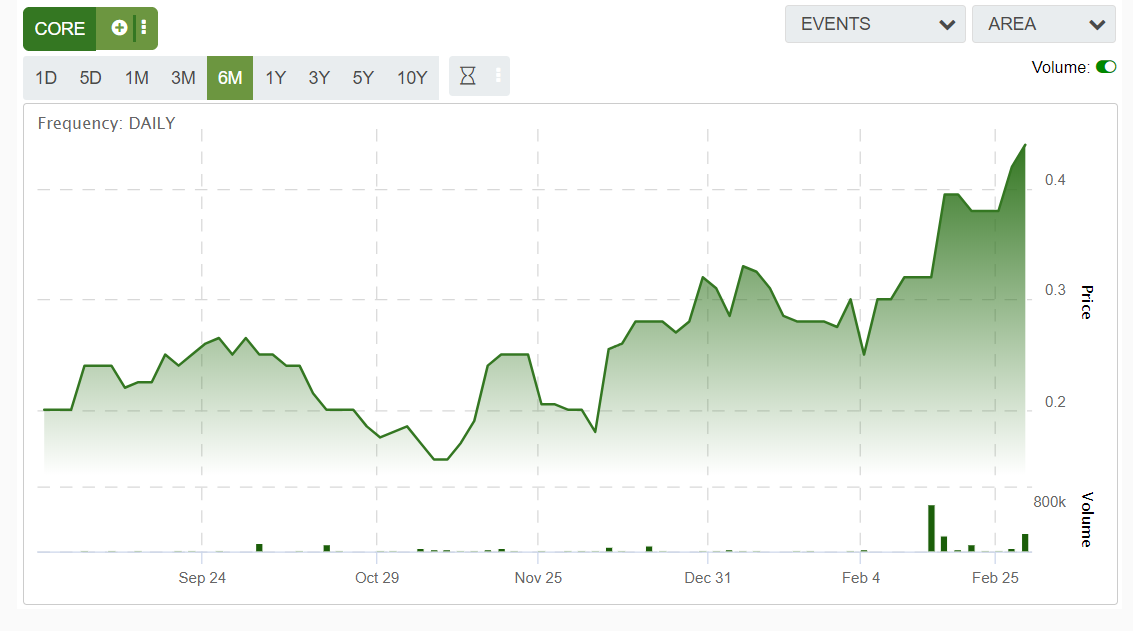
This hole was the highest grade reported on the property and it sparked interest from the market. Since that time, anticipation of further drilling has driven up share prices from 18 cents before the results to currently 34 cents per share.
Gordon McKinnon, President of Canadian Orebodies, stated:
“Our intersection from hole BR-2018-002 produced one of the highest-grade gold intercepts in the Hemlo Greenstone Belt outside of the Hemlo Mines complex, which was discovered in 1981. Looking into 2019, the combination of this season’s results, with the historic drilling results, will greatly improve our exploration model to expand the high-grade gold zones known in the system and to discover new ones.”
The significance of this new drill program is not be understated. There has been very little discovery since Hemlo, largely in part due to a lack of systematic exploration. Typically, the presence of one large orebody indicates the region has the geological potential to host further deposits, it is just a matter of getting the trend right and doing the drilling.
The main target of the 2019 drilling program is the Super G Structure of the Smoke Lake Gold System. Part of the program will target the up-dip and lateral extensions of the high-grade zone intersected in BR-2018-002.
The emerging picture suggests that the stacking of high and low grade gold zones is forming the Smoke Lake Gold System. The company is comparing its results to the width and grade of results from Amex Exploration’s (TSX-V: AMX) Eastern Gold Zone on its Perron Project.
Potential upside from the ongoing drill program could come from the extension of the discovered high-grade zone in the Super G Structure and extensions in its mineralization footprint. This could lead to the discovery of new high-grade zones in the other structures forming the Smoke Lake Gold System.
This work is going toward a larger regional picture of the potential for gold mineralization on the company’s land package. In 2017, drilling at the company’s Wire Lake project suggested that higher grade gold mineralization surrounded by a halo of lower grade mineralization can be hosted in the Wire Lake Gold System, with a headline result of 7.56 g/t gold over 4.9 metres in WL-2017-001 including 57.3 g/t gold over 0.5 metres (see release).
New geochemical data suggests that the Wire Lake Gold system is possibly related to the Smoke Lake Gold System, based on similarities between the alteration and mineralization in the two systems. If confirmed this would add an additional 5 kilometers to the Wire Lake Gold System which is already confirmed over a strike length of 3 kilometres, creating an even larger target in a underexplored greenstone belt.
This is just the beginning for the Canadian Orebodies team led by Gordon McKinnon. Calling on his family tradition, McKinnon has built a team that knows the region well and is looking to prove the continuity of his father’s success, who played a key role in the discovery of Hemlo.
On the board is John Harvey, who served as President and CEO of Hemlo Gold Mines Inc. from 1989 to 1991. Serving as an advisor to the company is Robert Middleton, who led the Rosario Resources team that discovered the Bell Creek Mine in Timmins, Ontario and, in 1982, he played a role in drilling the discovery hole at the Goliath Mine in Hemlo, Ontario.
Alongside this proven team is a series of successful shareholders such as Robert Cudney of Northfield Capital, who sold Gold Eagle Mines to Goldcorp for $1.5 billion, Sean Roosen’s Osisko Mining, Rob McEwen and Rick Rule. With these shareholders, the company has access to capital despite the company already being in a well-funded position with $2.2 million and ~58 million shares fully diluted.
The company is expecting the program to wrap in late March with assays shortly after that. These results could prove that there are more Hemlos in Ontario.
About Canadian Orebodies Inc.
Canadian Orebodies is a Canadian-based mineral exploration company with a portfolio of properties in Ontario and Nunavut. Canadian Orebodies is focused on generating shareholder value through the advancement of its two Hemlo area projects: Wire Lake and the North Limb.
By Nicholas LePan
March 14, 2019
The author of this article was compensated in cash and does not hold any securities in Canadian Orebodies.
- With little fanfare, gold is staging a nice consolidation in the $1280-$1350 price zone.
- Please click here now. Double-click to enlarge. A breakout from this $70 trading range would usher in a fresh target of $1400 and perhaps $1420.
- Note the superb position of the 14,7,7 series Stochastics oscillator at the bottom of the chart.
- Its great positioning is just one of many reasons why $1280 could be the launch pad for the next significant rally.
- Fundamentals make charts, and there are no long-term fundamentals more bullish for gold than the relentless growth of Chindian demand versus limited global mine supply growth.
- On that note, please click here now. Most American investors are wasting time begging the U.S. stock market to go higher, while the nation’s top institutional analysts are wisely focused on the incredibly bullish developments taking place in the Asian markets.
- Chinese government stimulus, rising demand for copper, and rising corporate earnings across Asia are all creating a stock market rally that could become a serious barn burner.
- That’s good news for physical market gold demand, which is good news for Western gold stock investors!
- Please click here now. The U.S. stock market situation is also positive for gold.
- Most U.S. stocks would have already melted far below their December lows if the Fed had not changed course so suddenly on rate hikes and quantitative tightening.
- U.S. first quarter GDP and earnings growth are likely abysmal, even after a major corporate tax cut, tariffs, ultra-low interest rates, and a mountain of stock market buybacks.
- Morgan Stanley analysts believe U.S. corporate earnings growth will fall to 1% in 2019 and I’ll suggest it would be negative if not for the stock market buybacks.
- Without the Fed’s backstop and the corporate buybacks, the U.S. stock market would probably be in free-fall right now.
- GDP growth in China is 6%+ and in India it is 7%+. The bottom line: Weakening growth in the West and solid growth in Asia is a win-win situation for gold.
- Please click here now. Double-click to enlarge this FXI-NYSE chart.
- The Chinese stock market just completed a textbook pullback to the neckline of a double bottom pattern after an upside breakout.
- With heavyweights like Morgan Stanley backing the rally, the Chinese stock market is likely headed much higher, and Asian investors will celebrate the upside action by purchasing gold.
- It’s mathematics as simple as 1+1=2.
- Central bank buying is another important factor for gold demand… and it’s accelerating.
- Please click here now. China’s central bank has resumed its monthly gold buying, and now India’s central bank seems to be buying consistently too!
- Please click here now. Double-click to enlarge this GDX chart.
- The bounce from the $21.50 support zone feels “perky”.
- Most intermediate and senior miners have made significant progress in cutting their AISC (all-in sustaining costs).
- A rally in bullion to above $1400 would turn many of these miners into “cash cows” and open the door to sustained institutional interest in the sector. That’s the main reason why I’m adamant that the entire $23 – $18 price zone for GDX is such an important buying area for investors!
Special Offer For Website Readers: Please send me an Email to freereports4@gracelandupdates.com and I’ll send you my free “Gold Portfolio With Silver Lining!” report. I highlight an ideal mix of gold and silver stocks for investors to profit as the gold price rally resumes!
Thanks!!
Stewart Thomson
March 13, 2019
Email:
Stewart Thomson is a retired Merrill Lynch broker. Stewart writes the Graceland Updates daily between 4am-7am. They are sent out around 8am-9am. The newsletter is attractively priced and the format is a unique numbered point form. Giving clarity of each point and saving valuable reading time.
Risks, Disclaimers, Legal
Stewart Thomson is no longer an investment advisor. The information provided by Stewart and Graceland Updates is for general information purposes only. Before taking any action on any investment, it is imperative that you consult with multiple properly licensed, experienced and qualified investment advisors and get numerous opinions before taking any action. Your minimum risk on any investment in the world is: 100% loss of all your money. You may be taking or preparing to take leveraged positions in investments and not know it, exposing yourself to unlimited risks. This is highly concerning if you are an investor in any derivatives products. There is an approx $700 trillion OTC Derivatives Iceberg with a tiny portion written off officially. The bottom line:
Are You Prepared?
It’s important to understand Gold’s fundamentals as it will help us confirm a new bull market.
To this point, Gold’s rallies have failed to make higher highs and higher lows because, although there has been improvement in fundamentals, the fundamentals have not turned bullish yet.
The technical trigger will be Gold and gold stock outperformance of the stock market which will likely lead to the fundamental catalyst of Fed rate cuts. The start of rate cuts will indicate declining real interest rates which is the key driver of bull markets in Gold.
With that said, here are some things that do not impact the price of Gold.
Geopolitics
This was borne out of the 1970s because geopolitical developments then did impact Gold. They affected Oil prices which impacts inflation. Random geopolitical events have no immediate impact on Gold unless they directly impact the fundamentals. Unless an event has immediate and sustained consequences for energy prices, it should be ignored and deemed short-term noise.
Central Bank Buying
This sounds impressive and important. Central Banks are powerful entities who help manage economies. Surely, they know something? According to Bloomberg, Central Banks are buying Gold at the fastest clip in almost 50 years!
The truth is Central Banks don’t have any inside information and their buying or selling cannot be used for market timing purposes. The chart below shows that the 2001-2011 run began with record central bank selling. Central Banks have been consistent buyers since the 2011 peak. If anything at all, the information is a contrary indicator.
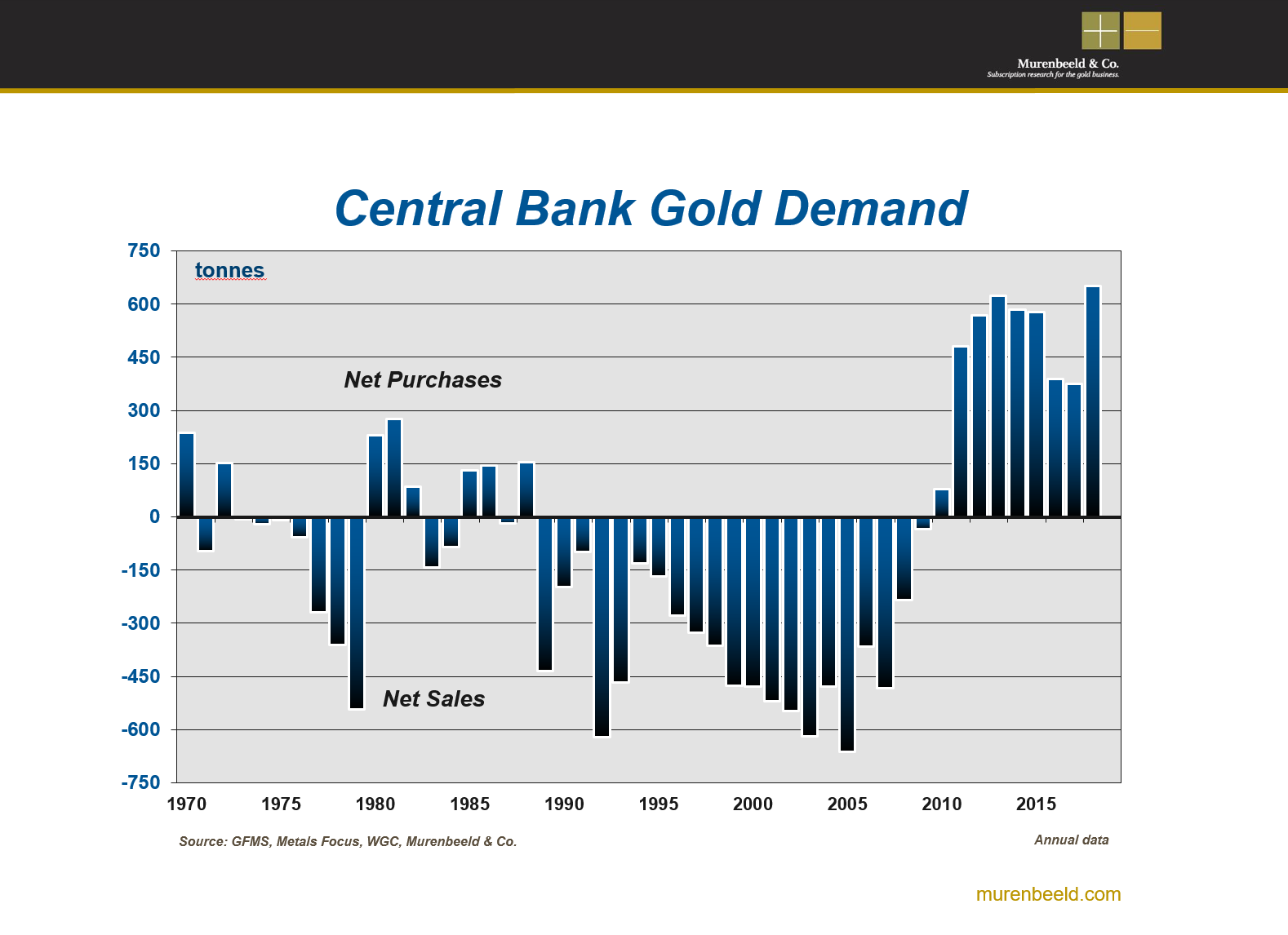
Supply & Demand
Gold is not like the other commodities. It acts far more like a currency as its drivers are inflation, interest rates and the U.S. Dollar.
The price of Gold doesn’t respond to changes in supply and demand. The chart below from Nick Laird shows that demand actually surged in the 1980s and 1990s, creating a rising deficit throughout the late 1980s and entire 1990s. But that was a time when the price trended sideways to lower.
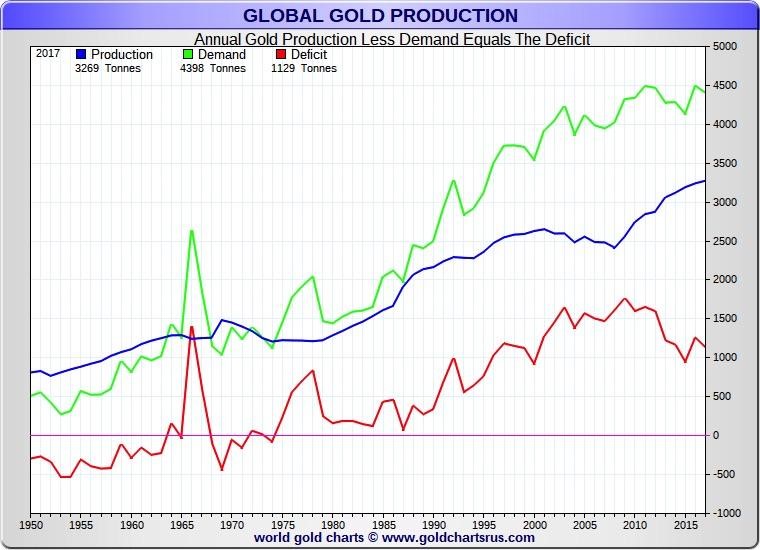
Part of the reason for that is jewelry demand is the largest component of Gold demand and it trends inversely to the Gold price.
It’s also important to note, Gold isn’t consumed like other commodities. Its supply grows in perpetuity. This is another reason its not impacted by supply and demand.
It’s also another reason why “Peak Gold” if true, will not impact the Gold price.
To sum things up, its ultimately inflation and interest rates which drive Gold because they drive real interest rates. Investment demand usually mirrors the trend in real interest rates and it impacts the price trend more than any other form of demand.
Other factors such as geopolitics, jewelry demand, Central Bank buying, Peak Gold and physical demand (which, if you read most gold bugs is always red hot) don’t impact the primary trend in the Gold price.
While Peak Gold or production difficulties do not affect the Gold price, they are hugely bullish for the companies that are making high margin discoveries or adding value to high margin deposits. Capital is flowing to the companies that are making these discoveries regardless of the trend in metals prices. When Gold fundamentals turn bullish, that is when massive amounts of capital will flow into juniors, creating a historic bull market. To learn which juniors have 3x to 5x potential over the next 12 to 18 months, consider learning more about our premium service.
The widely-held mega-cap stocks that dominate the U.S. markets recently finished reporting their Q4 2018 financial results. Because the tenor of stock markets changed radically last quarter, this latest earnings season is more important than usual. An extreme monster bull market suddenly rolled over into a severe near-bear correction in Q4. How major corporations fared offers insights into whether a young bear is upon us.
Four times a year publicly-traded companies release treasure troves of valuable information in the form of quarterly reports. Required by the U.S. Securities and Exchange Commission, these 10-Qs and 10-Ks contain the best fundamental data available to traders. They dispel all the sentiment distortions inevitably surrounding prevailing stock-price levels, revealing corporations’ underlying hard fundamental realities.
While 10-Qs with filing deadlines of 40 days after quarter-ends are required for normal quarters, 10-K annual reports are instead mandated after quarters ending fiscal years. Most big companies logically run their accounting on calendar years, so they issue 10-Ks after Q4s. Since these annual reports are larger and must be audited by independent CPAs, their filing deadlines are extended to 60 days after quarter-ends.
So the 10-K filing season just wrapped up last Friday, revealing how the biggest and best U.S. companies were doing in Q4 2018. They are the stocks of the flagship S&P 500 stock index (SPX). At the end of Q4 they commanded a gigantic collective market capitalization of $22.2t! The vast majority of investors own the big U.S. stocks of the SPX, as some combination of them are usually the top holdings of nearly every fund.
The major ETFs that track the S&P 500 dominate the increasingly-popular passive-investment strategies as well. The SPY SPDR S&P 500 ETF, IVV iShares Core S&P 500 ETF, and VOO Vanguard S&P 500 ETF are among the largest in the world. This past week they reported colossal net assets running $262.4b, $160.5b, and $103.2b respectively! Overall stock-market fortunes are totally dependent on big U.S. stocks.
Q4 2018 proved extraordinary. Leading into it, the SPX hit a dazzling all-time record high in late September about a week before Q4 arrived. That extended an extreme monster stock bull to 333.2% gains over 9.5 years, the 2nd-largest and 1st-longest in all of U.S. stock-market history! But as I warned days after that euphoric peaking, the Fed’s unprecedented quantitative-tightening campaign would finally ramp to full speed in Q4.
Stock markets artificially inflated by $3625b of Fed QE over 6.7 years couldn’t react well to Fed QT finally starting to unwind that epic monetary inflation. With QT hitting $50b per month starting in Q4, the stock markets indeed wilted. Over the next 3.1 months into Christmas Eve, the SPX plummeted 19.8%! That was right on the verge of a new bear market at -20%. The SPX suffered its worst December since 1931, -9.2%.
That sure looked like a young bear market, really freaking out traders. But since those deep and ominous lows, the SPX has soared 19.3% at best in a massive rally! That has reversed nearly 4/5ths of the total correction losses largely suffered in Q4. This looked and acted like a classic bear-market rally, rocketing higher to eradicate fear and restore universal complacency. New-bear worries have shriveled to nothing.
Given Q4 2018’s colossal stock-market inflection and subsequent huge rebound, whether the SPX narrowly evaded the overdue-bear bullet or not is supremely important. Bear markets exist for one reason, to maul overvalued stocks back down below historic fair-value levels. So how the major U.S. corporations actually fared last quarter, how large their earnings were compared to their stock prices, offers essential bull-bear clues.
Every quarter I analyze the top 34 SPX/SPY component stocks ranked by market cap. This is just an arbitrary number that fits neatly into the tables below, but is a dominant sample of the SPX. At the end of Q4, these American giants alone commanded fully 43.7% of the SPX’s total weight! Their $9.7t collective market cap exceeded that of the bottom 437 SPX companies. Big U.S. stocks’ importance cannot be overstated.
I wade through the 10-K or 10-Q SEC filings of these top SPX companies for a ton of fundamental data I dump into a spreadsheet for analysis. The highlights make it into these tables below. They start with each company’s symbol, weighting in the SPX and SPY, and market cap as of the final trading day of Q4 2018. That’s followed by the year-over-year change in each company’s market capitalization, a key metric.
Major U.S. corporations have been engaged in a wildly-unprecedented stock-buyback binge ever since the Fed forced interest rates to deep artificial lows during 2008’s stock panic. Thus the appreciation in their share prices also reflects shrinking shares outstanding. Looking at market-cap changes instead of just underlying share-price changes effectively normalizes out stock buybacks, offering purer views of value.
That’s followed by quarterly sales along with their y/y changes. Top-line revenues are one of the best indicators of businesses’ health. While profits can be easily manipulated quarter to quarter by playing with all kinds of accounting estimates, sales are tougher to artificially inflate. Ultimately sales growth is necessary for companies to expand, as bottom-line profits growth driven by cost-cutting is inherently limited.
Operating cash flows are also important, showing how much capital companies’ businesses are actually generating. Using cash to make more cash is a core tenet of capitalism. Unfortunately many companies are now obscuring quarterly OCFs by reporting them in year-to-date terms, lumping in multiple quarters together. So the Q4 2018 OCFs shown are mostly calculated by subtracting Q3’18 YTD OCFs from full-year ones.
Next are the actual hard quarterly earnings that must be reported to the SEC under Generally Accepted Accounting Principles. Lamentably companies now tend to use fake pro-forma earnings to downplay real GAAP results. These are derided as EBS profits, Everything but the Bad Stuff! Certain expenses are simply ignored on a pro-forma basis to artificially inflate reported corporate profits, often misleading traders.
While we’re also collecting the earnings-per-share data Wall Street loves, it’s more important to consider total profits. Stock buybacks are executed to manipulate EPS higher, because the shares-outstanding denominator of its calculation shrinks as shares are repurchased. Raw profits are a cleaner measure, again effectively neutralizing the impacts of stock buybacks. They better reflect underlying business performance.
Finally the trailing-twelve-month price-to-earnings ratios as of the end of Q4 2018 are noted. TTM P/Es look at the last four reported quarters of actual GAAP profits compared to prevailing stock prices. They are the gold-standard metric for valuations. Wall Street often intentionally conceals these hard P/Es by using the fictional forward P/Es instead, which are literally mere guesses about future profits that often prove far too optimistic.
These are mostly calendar-Q4 results, but some big U.S. stocks use fiscal quarters offset from normal ones. Walmart, Home Depot, and Cisco have quarters ending one month after calendar ones, so their results here are current to the end of January instead of December. Oracle uses quarters that end one month before calendar ones, so its results are as of the end of November. Offset reporting ought to be banned.
Reporting on offset quarters renders companies’ results way less comparable with the vast majority that report on calendar quarters. We traders all naturally think in calendar-quarter terms too. Decades ago there were valid business reasons to run on offset fiscal quarters. But today’s sophisticated accounting systems that are largely automated running in real-time eliminate all excuses for not reporting normally.
Stocks with symbols highlighted in blue have newly climbed into the ranks of the SPX’s top 34 companies over the past year, as investors bid up their stock prices and thus market caps relative to their peers. Overall the big U.S. stocks’ Q4 2018 results looked impressive, with good sales and profits growth. But that masks a sharp slowdown from prior quarters that will be exacerbated as the corporate-tax-cut transition year ends.
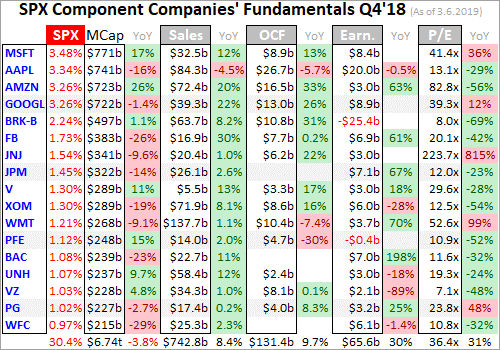
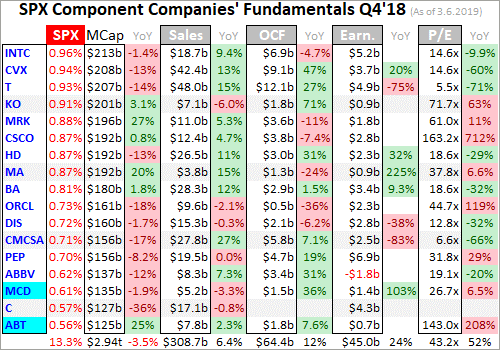
2018 was a banner year for corporate earnings because of Republicans’ massive corporate tax cuts. The Tax Cuts and Jobs Act was signed into law on December 22nd, 2017 to go into effect on January 1st, 2018. Its centerpiece was slashing the U.S. corporate tax rate from 35% to 21%, which naturally boosted reported profits. But 2018’s four quarters were the only ones that would experience anomalous TCJA growth.
Q4 2018 was the last quarter comparing year-over-year growth between a pre-TCJA quarter and post-TCJA quarter. That major discontinuity distorted corporate-earnings growth. Profits soared last year not just because companies were doing better, but because they were paying taxes at much-lower rates. But starting in Q1 2019, that TCJA-transition boost is gone forever. Normal same-tax-regime y/y comparisons will return.
But before we get to all-important corporate earnings and resulting valuations, let’s work our way through these tables. Thanks to the SPX’s brutal 14.0% plunge in Q4, this leading broad-market stock index lost 6.2% last year. The biggest and best US companies fared a little better, with the collective market cap of the top 34 sliding 5.2% y/y. These elite corporations had average market-cap losses running 3.6% y/y.
That certainly isn’t calamitous, but the deceleration is neck-snapping! In the prior four quarters starting in Q4 2017, the SPX’s top 34 components saw enormous average YoY market-cap gains of 29.2%, 14.6%, 23.5%, and 24.2%. Make no mistake, Q4’18 saw a massive and ominous stock-market inflection. The severe near-bear correction’s selling pressure was even heavier in smaller SPX stocks below the top 34.
That pushed the top 34’s share of the SPX’s total weighting to 43.7%, a big increase from Q4 2017’s 41.8%. The more capital concentrated in fewer stocks, the riskier the entire stock markets become. Big down days driven by company-specific news in highly-weighted individual stocks can drag down the entire stock markets. A great example occurred in mighty Apple just after Q4 ended, when it warned on weak Q4 sales.
For years Apple had been the largest U.S. stock by market cap, commanding the highest ranking in the SPX and SPY. Just after 2019’s first trading day closed, Apple cut its Q4 revenue guidance by 7.7% from its own midpoint given 2 months earlier. The next day AAPL stock collapsed by 10.0%, which pummeled the entire SPX 2.5% lower in its worst loss so far this year. When a top U.S. stock sneezes, markets catch a cold.
Falling stock markets exert a strong negative wealth effect. Both consumers and corporations get scared as stocks suffer big and fast drops, so they pull in their horns on spending. That left all kinds of economic data covering parts of Q4 weaker than expected, sometimes shockingly so. Lower spending weighs on corporate revenues, as fewer people buy less goods and services. Would the top 34’s Q4 2018 sales reflect this?
On the surface these biggest-and-best U.S. companies looked immune. Their total Q4 sales of $1051.6b still climbed an impressive 4.2% YoY in the stock markets’ worst quarter since Q3 2011. These companies averaged big sales growth of 7.4% y/y, which was surprisingly robust given the stock-market carnage. Yet even that good top-line growth still reflects a major slowdown for the top 34 from the past year’s pace.
In the preceding four quarters, the SPX’s top 34 component stocks averaged y/y revenues growth way up at 10.8%, 14.0%, 14.0%, and 11.5%. So Q4’s was a serious deceleration, which may be an ominous portent for 2019. Q4’s revenues growth may be overstated too. Nearly 2/3rds of the SPX’s spending-sapping Q4 plunge came in December alone, after much of the surge in holiday shopping was already over.
If big U.S. companies’ sales growth continues slowing or even starts shrinking in 2019, corporate-profits growth will collapse. While Q1 2019’s earnings season doesn’t start for another 5 weeks or so, plenty of companies have warned that they see revenues slowing much more than Wall Street expected. If Q4 2018 was indeed a major stock-market trend change from bull to bear, corporate results will continue deteriorating.
The mega-cap companies dominating the SPX and American investors’ portfolios also enjoyed strong operating-cash-flow-generation growth in Q4. Their collective OCFs surged 11.5% y/y to $195.8b. Individual companies enjoyed average OCF gains of 10.8% y/y. That looks great on the surface, but just like sales it represents a sharp slowdown from huge y/y OCF growth seen in the prior four quarters.
Starting in Q4 2017 the SPX top 34’s operating cash flows averaged growth of 17.0%, 52.5%, 30.3%, and 20.6% YoY. So Q4’18’s still-strong OCF growth actually decelerated by almost 2/3rds from the precedent of the prior year. That was the prevailing theme of Q4’18 results, good numbers but already slowing fast from the rest of 2018’s even though last quarter had easy annual comparisons across those corporate tax cuts.
Actual corporate profits among these elite U.S. companies are critical to prevailing valuations. The price-to-earnings ratio is the classic measure of how expensive stock prices are. It simply divides companies’ current stock prices by their total earnings per share over the last four reported quarters. So profits are really the only corporate results that matter for valuations, making their growth trends the most important of all.
Interestingly the top 34 SPX components’ total GAAP profits actually shrunk 1.4% y/y to $110.6b in Q4! That doesn’t make sense given their total revenues growth of 4.2%, which earnings should’ve amplified. But a couple big factors played into that surprising decline. After the Tax Cuts and Jobs Act was passed near the end of 2017, companies had to make huge adjustments to overpaid or underpaid taxes on their books.
These are called deferred tax assets and liabilities, which would suddenly be valued very differently under the new corporate-tax rules. So as I analyzed last year, the top 34 SPX companies ran a staggering $209.2b of TCJA adjustments through their earnings in Q4’17! Thus that earlier comparable quarter to Q4 2018 was a mess in GAAP-earnings terms. Q4 2017 was probably the most-distorted quarter in SPX history.
But with about half those one-time TCJA adjustments resulting in profits gains and half in losses, the net impact to overall SPX-top-34 earnings in Q4 2017 was essentially a wash at +$2.7b. That merely boosted overall Q4 2017 profits by 2.5%. A far-more-important factor in Q4’18’s YoY earnings decline came from a single company, Warren Buffett’s Berkshire Hathaway. It was the 5th-largest SPX component as 2018 ended.
BRK suffered a catastrophic $25.4b GAAP loss last quarter! That was almost entirely due to the sharp stock-market decline, which hammered Berkshire’s gigantic investment portfolio lower. It suffered $27.6b of non-cash losses that now have to be run through quarterly earnings. A new accounting rule now requires that unrealized capital gains and losses must be flushed through the bottom line, really irritating Buffett.
In BRK’s 2018 annual report he wrote “As I emphasized in the 2017 annual report, neither Berkshire’s Vice Chairman, Charlie Munger, nor I believe that rule to be sensible. Rather, both of us have consistently thought that at Berkshire this mark-to-market change would produce what I described as “wild and capricious swings in our bottom line.” … Wide swings in our quarterly GAAP earnings will inevitably continue.”
“That’s because our huge equity portfolio – valued at nearly $173 billion at the end of 2018 – will often experience one-day price fluctuations of $2 billion or more, all of which the new rule says must be dropped immediately to our bottom line. … Our advice? Focus on operating earnings, paying little attention to gains or losses of any variety.” Berkshire’s operating earnings were $5.7b in Q4’18, soaring 71.4% y/y!
If BRK’s epic unrealized capital loss is ignored, total SPX-top-34 earnings would’ve surged 23.2% y/y in Q4 2018. On average these top 34 SPX companies reporting profits in both Q4 2017 and Q4 2018 averaged similar 27.8% y/y gains. But the same sharp-deceleration story seen in revenues and OCFs also applies here. The previous four quarters saw far-stronger average growth of 137.0%, 45.9%, 44.5%, and 53.8% y/y!
The massive swings in Berkshire’s enormous investment portfolio are going to distort overall corporate profits in all future quarters with significant SPX gains or losses. We’ll have to watch that going forward, and adjust for it if necessary. But overall corporate profits will be much cleaner in coming years with the TCJA transition year of 2018 behind us. Apples-to-apples comparisons will once again become the norm.
The major slowdown in big U.S. companies’ revenues, operating cash flows, and earnings growth in Q4 2018 is certainly ominous. Especially since the majority of the SPX’s plunge last quarter came relatively late in December. But the most-important thing for attempting to divine whether that monster bull remains alive and well having merely suffered a severe correction, or a young bear is underway, is how valuations look.
These top 34 SPX companies that earned GAAP profits over the past four quarters averaged trailing-twelve-month price-to-earnings ratios way up at 39.7x as Q4 ended! That’s 29.4% above Q4 2017’s average a year earlier, and well into dangerous bubble territory. Over the past century-and-a-quarter or so, U.S. stock markets have averaged 14x earnings which is fair value. Twice that at 28x is where bubble territory begins.
Despite remaining scary-high, big U.S. companies’ average valuations did moderate considerably in Q4. The prior four quarters saw the SPX top 34’s average TTM P/Es run 30.6x, 46.0x, 53.4x, and 49.0x. So the severe near-bear correction definitely did some real work in mauling valuations down. And the P/Es in these tables are as of the end of Q4, which of course didn’t yet reflect the solid y/y growth in Q4 earnings.
By the end of February the top 34 SPX companies’ average TTM P/Es had further dropped to 26.4x, still very expensive but no longer bubble levels. That includes these Q4 results and is even despite the SPX’s powerful rebound rally out of late December’s near-bear lows. So the situation today is nowhere near as dire as at the end of Q4’18 on the valuation front. But that doesn’t mean stock markets are out of the woods.
Bear markets exist because stocks get too expensive leading into the ends of preceding bulls. At 14x fair value it takes 14 years for a company to earn back the price investors are paying for it. The reciprocal of that is a 7.1% return, which is mutually beneficial for both investors with surplus capital and companies that need it. Once extreme bubble valuations birth bear markets, they don’t hibernate until stocks are cheap.
Throughout all of 2018 the U.S. stock markets were trading at extreme bubble valuations. Then in Q4 that severe 19.8% correction hammered the SPX to the verge of formal bear territory. The rebound since has all the hallmarks of a massive bear-market rally. Wall Street’s oft-cited belief that Q4’s plunge was more than enough to restore balance to these stock markets isn’t credible. Bears don’t stop with stocks still expensive!
Historical bear markets after major bulls nearly always maul prevailing US-stock-market valuations back down to cheap levels at 7x to 10x earnings in TTM P/E terms. With the top U.S. stocks averaging 39.7x as Q4 waned and 26.4x at the end of February, the valuation-mean-reversion work still has a long way to go. It is certainly not safe to assume no bear is coming until the SPX trades under 14x, which is far lower.
The SPX soared 11.1% YTD by the end of February, hitting 2784.5. Merely to get to fair value at 14x earnings, not even overshoot to the downside, the SPX has to fall to 1476.6! That’s another 46.7% under this week’s levels! And if corporate earnings actually start retreating this year, the SPX downside targets will fall proportionally. Big bears are normal and inevitable after big bulls, as I explained in depth in late December.
Nearly a decade of Fed-QE-goosed bull market has left traders forgetting how dangerous bears are. The SPX’s last two bears were a 49.1% decline over 2.6 years ending in October 2002, and a 56.8% plunge in 1.4 years climaxing in a stock panic to a March 2009 low! With the big U.S. stocks sporting extreme bubble valuations all of last year, and still near bubble valuations now, it’s hard to believe we aren’t in a young bear.
If that proves true, investors need to lighten up on their stock-heavy portfolios, or at least put stop losses in place. Cash is king in bear markets, since its buying power grows. Investors who hold cash during a 50% bear market can double their holdings at the bottom by buying back their stocks at half-price. But cash doesn’t appreciate in value like gold, which actually grows wealth during major stock-market bears.
Gold investment demand surges as stock markets weaken, as we got a taste of in December. While the SPX plunged 9.2%, gold rallied 4.9% as investors flocked back. The gold miners’ stocks which leverage gold’s gains fared even better, with their leading index surging 10.7% higher. The last time a major SPX selloff awakened gold in the first half of 2016, it soared 30% higher fueling a massive 182% gold-stock upleg!
Absolutely essential in bear markets is cultivating excellent contrarian intelligence sources. That’s our specialty at Zeal. After decades studying the markets and trading, we really walk the contrarian walk. We buy low when few others will, so we can later sell high when few others can. While Wall Street will deny this likely young stock-market bear all the way down, we will help you both understand it and prosper during it.
We’ve long published acclaimed weekly and monthly newsletters for speculators and investors. They draw on my vast experience, knowledge, wisdom, and ongoing research to explain what’s going on in the markets, why, and how to trade them with specific stocks. As of Q4, we’ve recommended and realized 1076 newsletter stock trades since 2001. Their average annualized realized gain is +16.1%! That’s nearly double the long-term stock-market average. Subscribe today for just $12 per issue!
The bottom line is big U.S. stocks’ Q4 2018 results looked impressive on the surface. Good annual growth in sales, operating cash flows, and even earnings excluding Berkshire’s huge mark-to-market losses appeared to buck Q4’s major stock-market selloff. But these growth rates all suffered sharp decelerations from those seen in preceding quarters, suggesting a slowdown is underway. That’s a real problem for stock markets.
Valuations remain dangerously high, deep into bubble territory at the end of Q4. And even after the Q4 earnings were included by late February, near-bubble valuations persisted. That means the likely bear has barely started its stock-price-mauling work to mean revert expensive valuations. On top of that, 2018’s anomalous corporate-tax-cut-transition growth rates are history. All this will continue to pressure stock prices.
Adam Hamilton, CPA
March 11, 2019
Copyright 2000 – 2019 Zeal LLC (www.ZealLLC.com)
The recent rally showed quite a bit of promise.
Gold stocks surged past their long-term moving averages while breadth indicators surpassed all prior bear market peaks (excluding 2016). 71% of the HUI and 81% of GDXJ closed above the 200-day moving average.
GDX and GDXJ looked to be on their way to $25 and $37, with Gold approaching $1360/oz and those breadth figures on the way to hitting 90%.
However, the stock market rebound pushed past its initial resistance and precious metals reversed course yet again before hitting those targets.
Other than 1985-1987 there has never been a bull market in precious metals without their simultaneous outperformance of the stock market.
Gold stocks and Gold especially have trended lower against the stock market since the end of December. The price action suggests this relative weakness should continue over the days and weeks ahead. If the ratios in the chart below lose the 200-day moving average then the next strong support becomes the 2018 autumn lows.
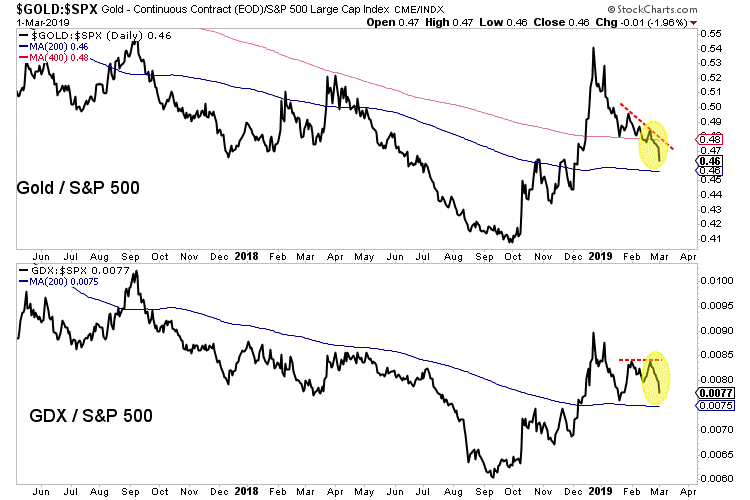
It was also disappointing that Gold peaked prior to touching $1360/oz. This leaves a noticeable lower high on the chart.
Meanwhile, Silver did not confirm Gold’s rise in February. It formed a double top as twice it failed at a confluence of resistance at $16.00/oz.
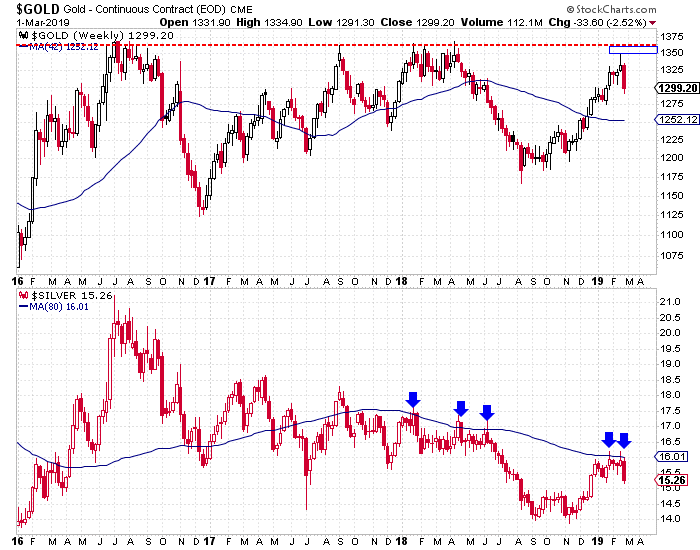
Turning to the gold stocks, we find the price action of the past two weeks is similar to the peaks in summer 2017 and January 2018.
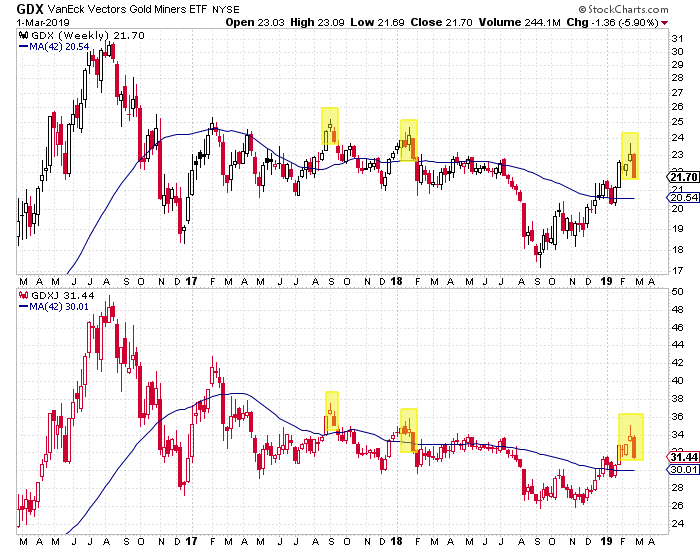
February 2019 figures to mark at least an interim peak in precious metals. The next key support for Gold and the gold stocks are the 200-day moving averages.
If the gold stocks can maintain recent breadth gains then the 200-day moving averages could mark an important low within a fledgling uptrend. If not, then a retest of the 2018 lows (especially in the gold stocks and Silver) becomes a stronger possibility.
As we noted last week, the near-term outlook for the stock market is bullish and in the current context that is negative for precious metals which cannot breakout or begin a bull market until the Fed turns from a pause to rate cuts.
Plenty of values remain in the mining equities and we should see more come about as spring beckons. To learn which juniors have 3x and 5x potential over the next 12-18 months, consider learning more about our premium service.
- The U.S. stock market and bullion swooned yesterday, but the GDX gold stocks ETF was up!
- Gold stocks continue to perform impressively. Rallies look impulsive and corrections feel solid.
- Please click here now. Double-click to enlarge this daily gold chart. Gold has pulled back by about 30% after staging an enormous $170/ounce rally.
- In the scenario shown on this chart, gold could trade down to the 50% retracement area and support zone at $1250-$1260.
- From there, the rally would resume and gold should surge to my next $1400 target zone.
- The next U.S. jobs report is on Friday, and that report is likely to help indicate whether gold range trades or pulls back to $1260 or so before that rally to $1400 takes place.
- Please click here now. Double-click to enlarge. My alternative scenario has the current area as the correction low, and a range trade between $1275 and $1350 would occur over the next few months.
- Even though gold has corrected by about $70 from the $1350 zone, some individual miners have barely corrected at all. This is another sign of a very healthy market.
- Over the weekend, some readers told me they were worried that Goldman Sachs’ influential analysts may be about to lower their $1425 gold price target back down to $1050.
- With thanks to the forexLive team, I’d like to put that worry to rest. For the good news, please click here now. Not only are Goldman’s analysts still positive about gold…
- They are raising their target prices!
- The Western gold community can relax and enjoy this price pullback because there’s nothing to fear and everything is fundamentally solid.
- Please click here now. There’s an important double bottom pattern in play on this FXI-NYSE Chinese stock market chart.
- I’ll also note that it closed higher yesterday while the American Dow fell hard. Tariffs progress, government stimulus, and bigger weighting in international indexes should push the FXI higher.
- In turn, that’s going to put Chinese citizens in a positive mood and make them eager to buy more gold.
- Please click here now. Double-click to enlarge this superb SIL silver stocks ETF chart.
- All silver stock enthusiasts should feel confident and happy when looking at this chart. That’s because the slope of the current uptrend is solid and sustainable.
- Violent rallies like the one in 2016 are not sustainable. They cause a lot of investor price chasing as they peak and tend to end very badly.
- The fundamentals of this market are much different from 2016. That’s why key research analysts at firms like Goldman are so positive on gold. Where gold goes, silver tends to follow.
- Silver can outperform gold without leading it. What I mean by that statement is that gold can be the first metal to make a new intermediate trend high, but the percentage gains for that move are bigger for silver. When silver leads gold, the market tends to be more speculative and that’s not healthy.
- Gains that are sustained come from a market where gold leads the trending action, and that’s what is happening now.
- Please click here now. Monster bank BMO says that the combination of falling mine supply and rising jewellery demand will provide a “tailwind” for the price of gold, propelling it higher into 2021.
- Some bank analysts feel mine supply will decline, some see it static, and some see it rising, but only slightly, but almost all of them see demand bigger than supply. Government debt and de-dollarization are likely to become much more significant drivers of demand by 2021 than they are now. Both the fear trade and the love trade should be solid tailwinds for gold in the years ahead.
- Please click here now. Double-click to enlarge. GDX bounced nicely off the $21.50 support zone yesterday. More gyration is likely, but I think GDX will rise above $24 before gold moves over $1350. This market is solid. Gold stocks look like tourists in a bus climbing up a mountain of fiat at a leisurely pace. My suggestion: Enjoy the ride!
Special Offer For Website Readers: Please send me an Email to freereports4@gracelandupdates.com and I’ll send you my “Golden Ten Baggers!” report. I highlight key gold stocks trading under $10 that are poised for ten bagger gains as gold moves to $1400! I include buy and sell tactics to help investors manage the action professionally!
Thanks!!
Stewart Thomson
Email:
Stewart Thomson is a retired Merrill Lynch broker. Stewart writes the Graceland Updates daily between 4am-7am. They are sent out around 8am-9am. The newsletter is attractively priced and the format is a unique numbered point form. Giving clarity of each point and saving valuable reading time.
Risks, Disclaimers, Legal
Stewart Thomson is no longer an investment advisor. The information provided by Stewart and Graceland Updates is for general information purposes only. Before taking any action on any investment, it is imperative that you consult with multiple properly licensed, experienced and qualified investment advisors and get numerous opinions before taking any action. Your minimum risk on any investment in the world is: 100% loss of all your money. You may be taking or preparing to take leveraged positions in investments and not know it, exposing yourself to unlimited risks. This is highly concerning if you are an investor in any derivatives products. There is an approx $700 trillion OTC Derivatives Iceberg with a tiny portion written off officially. The bottom line:
Are You Prepared?
The battle for Cornerstone Capital Resources Inc. (TSXV-CGP, OTC-CTNXF) is heating up following a preliminary takeover bid from joint venture partner SolGold. However, Cornerstone is likely to reject the overture, based on its latest press release on the matter and on comments by Glen McKay, a co-founder and former president and CEO of the junior mining exploration company.
Cornerstone has a joint venture agreement with SolGold on the Cascabel project in Ecuador, which is believed to be one of the world’s largest gold-copper deposits. SolGold is the operator of the Cascabel project and owns a majority stake. Larger gold players are also involved, with both BHP Billiton and Newcrest Mining holding minority positions in SolGold.
In a February 8 press release, Cornerstone noted that SolGold had issued a press release of its own on January 31, announcing its intention to commence an offer to acquire all of the issued and outstanding common shares of Cornerstone in an all-stock transaction, providing 0.55 of a SolGold share for every one Cornerstone share tendered.
“As previously announced by Cornerstone, shareholders of the company that collectively own over 50% of the company’s outstanding shares have notified Cornerstone that they will not support the terms announced by SolGold,” the Cornerstone release stated. “As a result, if SolGold proceeds to make a formal offer on these terms, the company believes that SolGold’s offer would be incapable of being successfully completed.”
The Board of Directors of Cornerstone said it had assessed the SolGold proposal with its financial advisor and believes that the proposal significantly undervalues Cornerstone. The Cascabel Project is owned by SolGold’s 85% owned Ecuador subsidiary Exploraciones Novomining S.A. (ENSA). The remaining 15% of ENSA is currently held by Cornerstone. In addition, Cornerstone owns approximately 9.2% of the outstanding shares of SolGold. In effect, Cornerstone has a combined direct and indirect 23% interest in the Cascabel concession.

Cornerstone said it was disappointed by SolGold’s latest press release, stating that it contains “numerous inaccurate and misleading statements and baseless innuendo.” Still, Cornerstone said it remains open to constructively discussing with SolGold and other potential bidders any value enhancing transaction that would garner the support of Cornerstone’s shareholders.
In an interview, Cornerstone co-founder and former chief executive Glen McKay called the SolGold preliminary offer a poor bid, or an offer so far below the current value that under most circumstances it will be rejected. McKay is a major shareholder and a special advisor to Cornerstone. “I know that we can identify 60% of shareholders who have been surveyed and unanimously we are going to reject the offer, if SolGold comes with it,” McKay said. “They may still come with an offer, but it will be a waste of their money to do so and will be really embarrassing for SolGold.” An additional factor is that SolGold is mostly an illiquid stock so that even if Cornerstone accepted the deal there would be little chance of current CGP shareholders being able to monetize their new shares of SolGold in the short term.
The price SolGold is offering is not based on the fair value of the Cascabel project, McKay said. In addition, he says there are a number of issues with the joint venture agreement between SolGold and Cornerstone that have not been fulfilled.
This may not be an issue in the future, if BHP Billiton or Newcrest or some other suitor comes in with an offer for both companies and consolidates them. But for now, McKay says SolGold is not in a position of strength and the deal as it stands is “not going to happen.”
Stressing that he can’t predict the future, McKay nonetheless believes that another bid for Cornerstone will take place, perhaps as soon as this year. Although BHP Billiton has signed a deal which rules out a takeover bid until November, Newcrest Mining is under no such restriction.
Newcrest has signed two major joint venture agreements with Cornerstone in the last couple of months, McKay notes, including an agreement on the Cana Brava project in Ecuador and the Miocene property in Chile.
McKay sees the two deals as an indication that Newcrest is positioning itself for a bid so that they are in a good place in terms of their relationship with Cornerstone. “If I had to make a bet, I would say that Newcrest is the front runner and it may be that they will do it as a partnership,” he says. “I think something will happen before the end of 2019. We’re hoping that another interested player comes in and starts a bidding war.”
With consolidation on the rise in the metals sector, a SolGold-Cornerstone merger perhaps makes sense, although SolGold may have to sweeten its offer to cement the deal. But Cornerstone’s initial negative response suggests even that won’t be enough. For now, interested observers will have to be content to wait for another missive from SolGold to see if the offer changes or is simply shelved.
Whatever the outcome, McKay believes that Cornerstone will spin off its other assets before a sale of its interest in Cascabel due to the potential of other properties that are under other JVs such as the Bramaderos project in Ecuador. Malcolm Norris, the CEO of Cornerstone partner (Sunstone) on the project was the CEO of SolGold in 2012 when Cornerstone completed a JV deal on Cascabel. Norris and Cornerstone VP Exploration Yvan Crepeau are due the credit for the discovery of Cascabel, McKay says. They are hoping to replicate that success on Bramaderos.
Here are today’s videos and charts (double-click to enlarge):
SFS Key Charts, Signals, & Video Analysis
I’m quite excited about the pullback in gold because the fundamentals are getting better and the technical action is healthy.
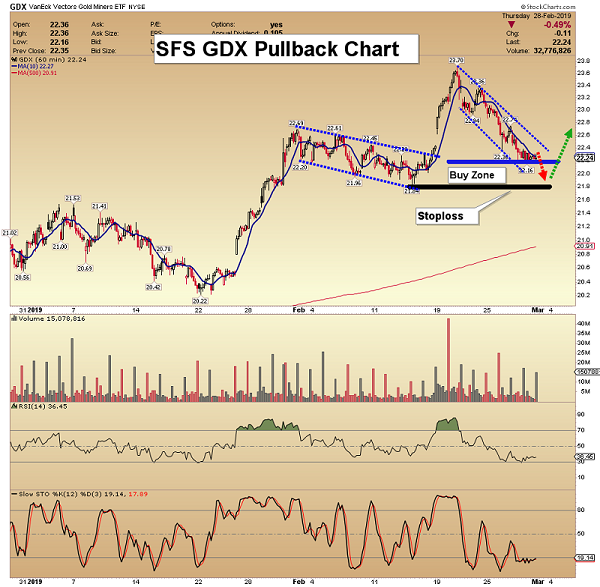
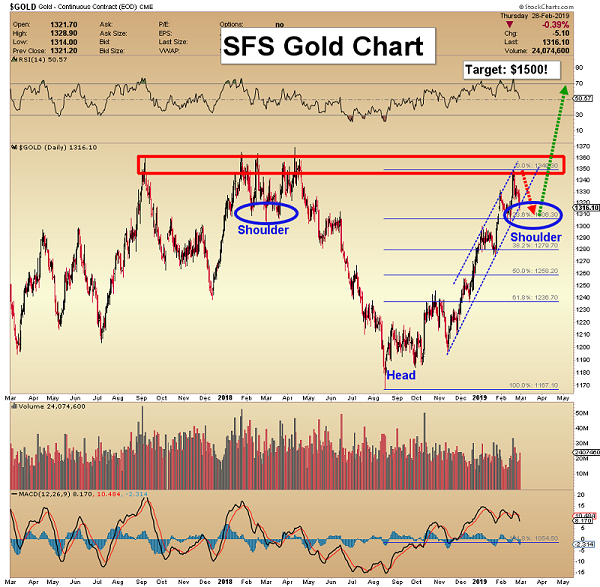
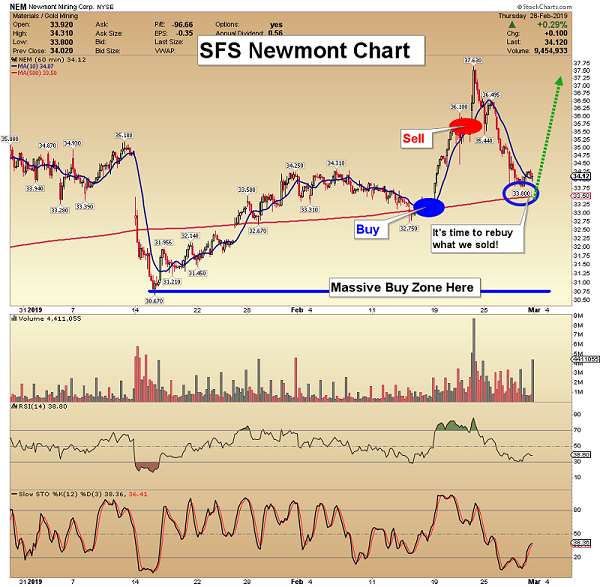
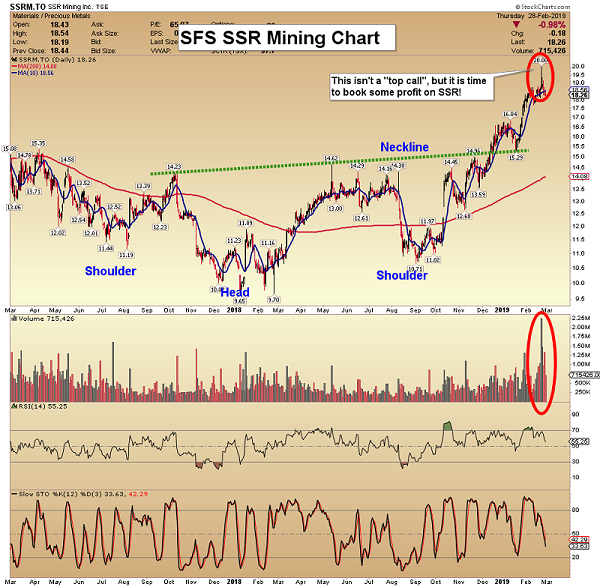
SF60 Key Charts, Signals, & Video Analysis
Kirkland is a leader in the gold stock sector and it’s now in one of the important Investor’s Business Daily growth stock indexes.
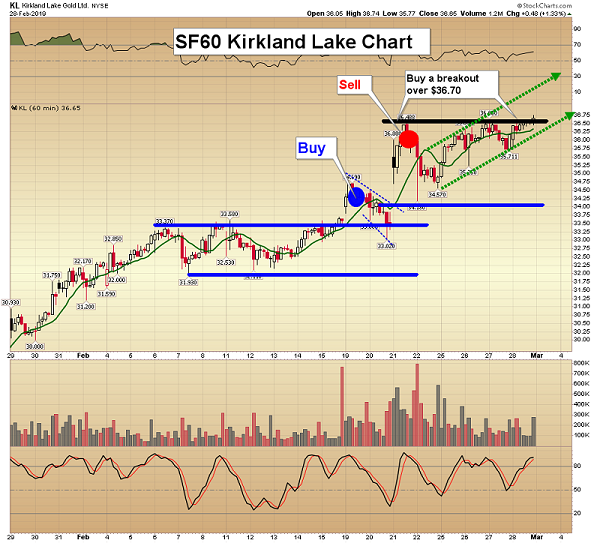
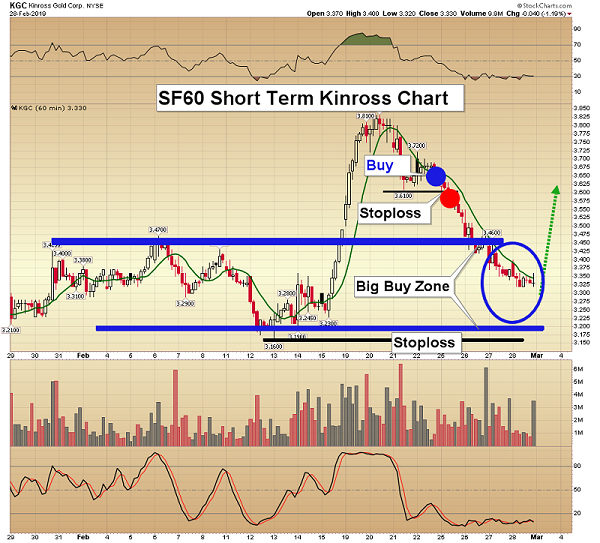
SF Trader Key Charts, Signals, & Video Analysis
Our positioning into DUST was timely!
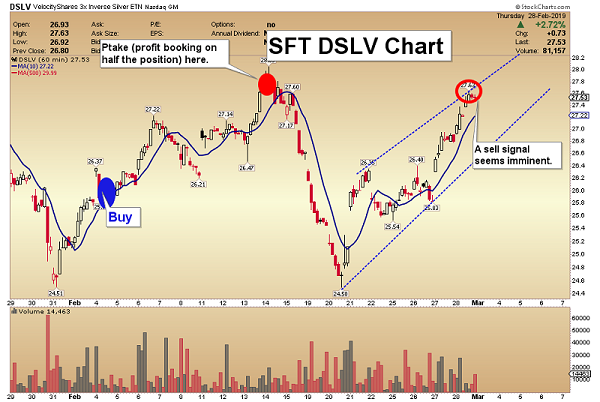
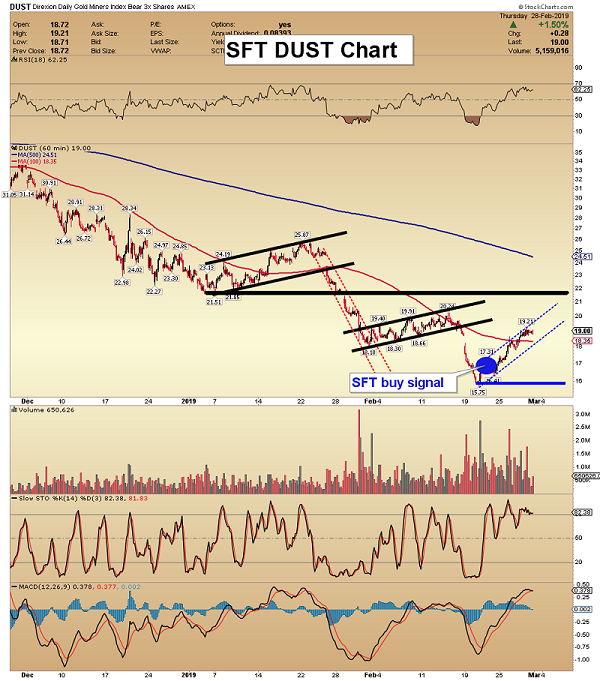
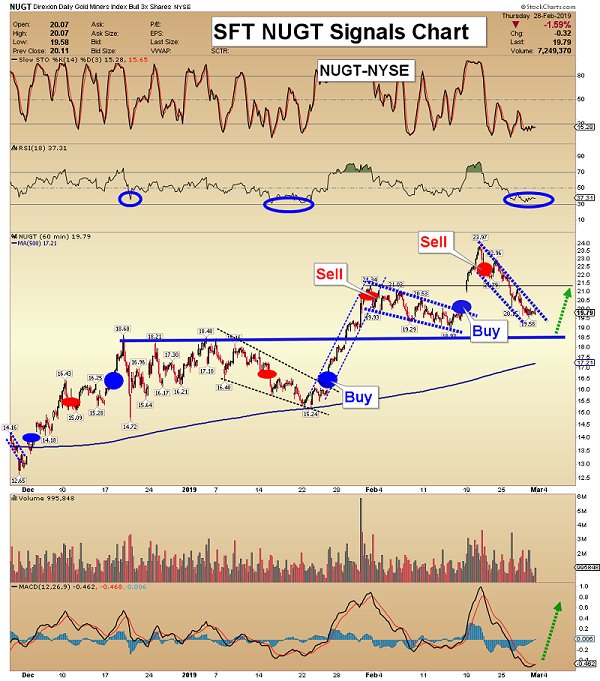
SFJ Key Charts, Signals, & Video Analysis
Prudent profit booking into strength in this gold bull market is important.
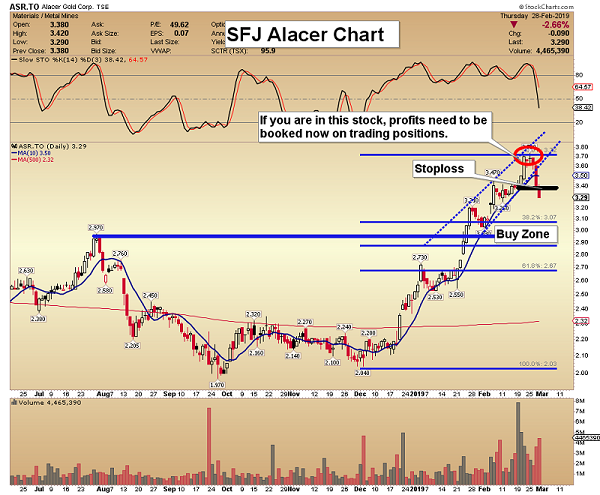
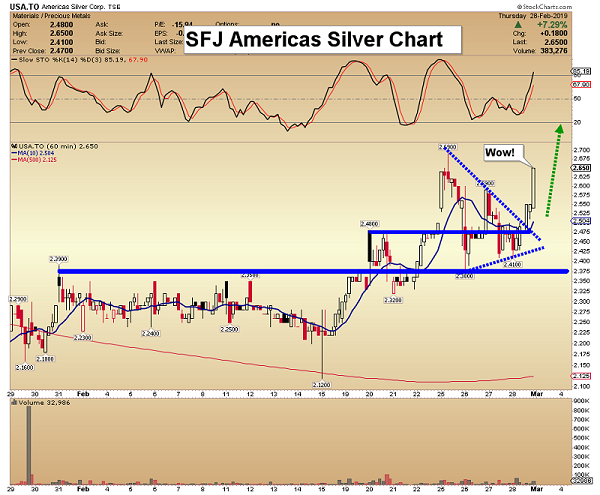
Thanks,
Morris Hubbartt
Unique Introduction For Website Readers: Send me an email to signals@superforcesignals.com and I’ll send you 3 of my next Super Force Surge Signals free of charge, as I send them to paid subscribers. Thank you!
Stay alert for our Super Force alerts, sent by email to subscribers, for both the daily charts on Super Force Signals at www.superforcesignals.com and for the 60 minute charts at www.superforce60.com
Frank Johnson: Executive Editor, Macro Risk Manager.
Morris Hubbartt: Chief Market Analyst, Trading Risk Specialist.
Email:
The gold miners’ stocks have been climbing higher on balance, enjoying a solid upleg that is gathering steam. That’s fueling improving sentiment, driving more interest in this small contrarian sector. This gold-stock upleg is likely to grow in coming months, partially because of very-favorable spring seasonals. The gold stocks’ second-strongest seasonal rally of the year typically unfolds between mid-March to early June.
Seasonality is the tendency for prices to exhibit recurring patterns at certain times during the calendar year. While seasonality doesn’t drive price action, it quantifies annually-repeating behavior driven by sentiment, technicals, and fundamentals. We humans are creatures of habit and herd, which naturally colors our trading decisions. The calendar year’s passage affects the timing and intensity of buying and selling.
Gold stocks exhibit strong seasonality because their price action mirrors that of their dominant primary driver, gold. Gold’s seasonality generally isn’t driven by supply fluctuations like grown commodities experience, as its mined supply remains fairly steady year-round. Instead gold’s major seasonality is demand-driven, with global investment demand varying dramatically depending on the time in the calendar year.
This gold seasonality is fueled by well-known income-cycle and cultural drivers of outsized gold demand from around the world. The seasonal gold year starts in late July as Asian farmers begin reaping their harvests. They plow some of their surplus income into gold. That’s soon followed by the famous Indian wedding season in autumn, with its heavy gold buying for brides’ dowries during marriage-auspicious festivals.
After that comes the Western holiday season, where gold jewelry demand surges for Christmas gifts for wives, girlfriends, daughters, and mothers. Following year-end, Western investment demand balloons after bonuses and tax calculations as investors figure out how much surplus income the prior year generated for investment. Then after that Chinese New Year gold buying flares up heading into February.
These understandable cultural factors drive surges of outsized gold demand between late summer and late winter. But interestingly there is one more gold-demand spike in spring. Over the years I’ve seen a variety of theses explaining this mid-March-to-late-May gold rally, but nothing definitive like for the rest of the year’s seasonality. As silly as it sounds, I suspect spring itself is the reason for this demand surge.
Sentiment exceedingly influences investing, which requires optimism for the future. Investors won’t risk deploying their scarce capital unless they believe it will grow. And the glorious expanding sunshine and warming temperatures of spring naturally breed optimism. The vast majority of the world’s investors are far enough into the northern hemisphere that spring has a major psychological impact, buoying their spirits.
Since it is gold’s own demand-driven seasonality that fuels the gold stocks’ seasonality, that’s logically the best place to start to understand what’s likely coming. Price action is very different between bull and bear years, and gold remains in a young bull market. After being crushed to a 6.1-year secular low in mid-December 2015 on the Fed’s first rate hike of this cycle, gold blasted 29.9% higher over the next 6.7 months.
Crossing the +20% threshold in March 2016 confirmed a new bull market was underway. Gold corrected after that sharp initial upleg, but normal healthy selling was greatly exacerbated after Trump’s surprise election win. Investors fled gold to chase the taxphoria stock-market surge. Gold’s correction cascaded to mammoth proportions, hitting -17.3% in mid-December 2016. But that remained shy of a new bear’s -20%.
Gold’s last mighty bull market ran from April 2001 to August 2011, where it soared 638.2% higher! And while gold consolidated high in 2012, that was technically a bull year too since gold just slid 18.8% at worst from its bull-market peak. Gold didn’t enter formal bear-market territory at -20% until April 2013, thanks to the crazy stock-market levitation driven by extreme distortions from the Fed’s QE3 bond monetizations.
So the bull-market years for gold in modern history ran from 2001 to 2012, skipped the intervening bear-market years of 2013 to 2015, and resumed in 2016 to 2019. Thus these are the years most relevant to understanding gold’s typical seasonal performance throughout the calendar year. We’re interested in bull-market seasonality, because gold remains in its latest bull today and bear-market action is quite dissimilar.
Prevailing gold prices varied radically throughout these modern bull-market years, running between $257 when gold’s last secular bull was born to $1894 when it peaked a decade later. All these years along with gold’s current bull since 2016 have to first be rendered in like-percentage terms in order to make them perfectly comparable. Only then can they be averaged together to distill out gold’s bull-market seasonality.
That’s accomplished by individually indexing each calendar year’s gold price action to its final close of the preceding year, which is recast at 100. Then all gold price action of the following year is calculated off that common indexed baseline, normalizing all years regardless of price levels. So gold trading at an indexed level of 105 simply means it has rallied 5% from the prior year’s close, while 95 shows it’s down 5%.
This chart averages the individually-indexed full-year gold performances in those bull-market years from 2001 to 2012 and 2016 to 2018. 2019 isn’t included yet since it remains a work in progress. This bull-market-seasonality methodology reveals that gold’s spring rally is its last push higher before the summer doldrums arrive. While this is gold’s smallest seasonal rally of the year, the gold stocks greatly leverage it.
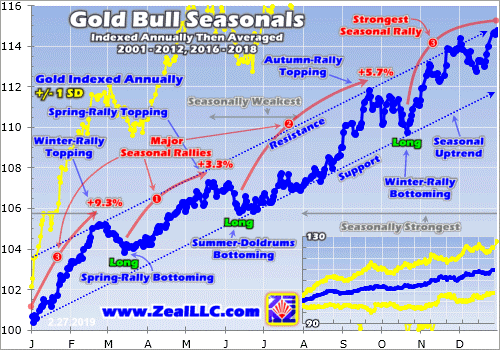
During these modern bull-market years from 2001 to 2012 and 2016 to 2018, gold’s spring rally tended to start in mid-March on average. From that major seasonal low following the winter rally, gold often starts grinding higher before its gains accelerate through April and much of May. This spring rally has generally run its course by late May. Across the 15 bull years in this study, gold averaged modest spring rallies of 3.3%.
This spring rally unfolds rapidly, with an average duration of just 2.2 months. That makes it the smallest and shortest of gold’s three major seasonal rallies, falling way behind the champion 9.3% winter rally that precedes it and the strong 5.7% autumn rally that follows the summer doldrums. Nevertheless, it is still well worth trading. 3.3% gains do really make a difference, and naturally about half of years exceed this mean.
On average gold’s spring-rally bottoming occurred on March’s 10th trading day, which will be the 14th this year. If today’s seasonals stay true to form, gold will slump in the first couple weeks of March. But that seasonal pullback between the winter and spring rallies is pretty modest, averaging just 1.3% over a few weeks at most. The resulting mid-March lull in gold prices spawns an excellent gold-stock buying opportunity.
Gold’s average seasonal performances in March, April, and May during these modern bull-market years ran -0.3%, +1.6%, and +0.6%. While even April is just gold’s 6th-best month of the year, it still has an outsized impact on gold-stock prices. This has to be sentiment-driven. Optimism runs high in the spring anyway, and plenty of bullish psychology lingers following gold stocks’ strong winter rally in preceding months.
This year’s spring gold rally has excellent potential to come in on the large side. Gold investment demand surged in Q4’18 as global stock markets crumbled. They are likely rolling over into a long-overdue major bear. When investors start worrying its next major downleg is brewing, they will again flood into gold to continue diversifying their stock-heavy portfolios. Surging gold investment demand propels gold strongly higher.
That may push gold to the verge of a major decisive breakout to new bull highs! At best in February, gold hit $1341 on close. Assuming a 1.3% early-March seasonal pullback before a typical 3.3% spring rally, gold would hit $1367. That’s just above its bull-to-date peak of $1365 seen way back in early July 2016. Investor and speculator interest in gold, and capital inflows into it, will explode as new bull highs are achieved.
And as goes gold, so go gold stocks. Gold stocks also exhibit strong seasonality, which is of course the direct result of gold’s own seasonality. Since gold-mining costs are largely fixed when mines are being planned, fluctuations in gold’s price flow directly into amplified moves in gold-mining profits. Higher gold prices drive much-higher earnings for the gold miners, which attract in more investors to bid up stock prices.
The ironclad historical relationship between the price of gold, gold-mining profitability, and therefore gold-stock price levels is exceedingly important to understand. If you need to get up to speed, I wrote an essay looking at gold-stock price levels relative to gold early last month. Fundamentally gold stocks are leveraged plays on gold, and greatly outperform in the spring on gold’s seasonals and general optimism.
This next chart applies this same bull-market-seasonality methodology used on gold directly to the gold stocks. It looks at the average annual indexed performance in the flagship HUI NYSE Arca Gold BUGS Index in these same bull-market years of 2001 to 2012 and 2016 to 2018. Using the HUI is necessary because the popular GDX VanEck Vectors Gold Miners ETF was only born in May 2006, missing bull years.
That was halfway into the last secular gold-stock bull, which ran from November 2000 to September 2011. Over that long 10.8-year span, the HUI skyrocketed a life-changing 1664.4% higher on gold’s parallel 638.2% bull! Gold-stock prices naturally mirror and amplify gold action since it dominates gold-mining earnings. That’s true across entire secular bulls, within individual uplegs, and even in calendar-year seasons.
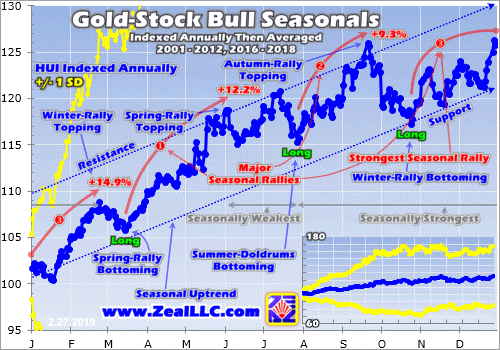
Gold stocks’ seasonal spring rally is much stronger than gold’s, buttressing that spring-optimism-drives-stock-buying thesis. Between mid-March and early June, the gold stocks have averaged hefty 12.2% rallies in these 15 modern bull-market years. That makes for exceptional 3.7x upside leverage to gold’s 3.3% seasonal spring rally! Interestingly this is gold stocks’ best seasonal leverage to gold’s gains by far.
While the HUI averaged 14.9% surges during gold’s winter rally, that only made for 1.6x upside leverage to gold’s big 9.3% gain. And the HUI’s 9.3% average gain during gold’s autumn rally also only amplified gold’s 5.7% gain by 1.6x. So while the gold-stock spring rally’s 12.2% average gains rank second out of these three seasonal rallies, it offers the most bang for the buck in gold-stock upside compared to gold!
Like gold, the gold miners’ stocks suffer a seasonal slump from late February to mid-March. That has averaged 2.7% in these modern bull-market years. So don’t be worried into selling if we see a typical early-March slump in this sector. That’s usually just a mild pullback before gold stocks’ strong spring rally gets underway. Any seasonal weakness is a great opportunity to add new gold-stock trades relatively low.
The gold stocks’ post-winter-rally pre-spring-rally lull tends to bottom on March’s 11th trading day, which will be the 15th this year. From there the HUI surges 12.2% higher on average over the next 2.7 months into early June. Interestingly the gold stocks tend to top a couple weeks after gold peaks in late May. That’s likely the result of momentum fueled by spring optimism and strong gains since the prior summer.
Assuming this year’s gold-stock seasonals conform to their bull-year precedent in coming months, some impressive levels are coming before summer. If the HUI first retreats 2.7% from its February peak into mid-March before powering 12.2% higher into early June, we are looking at 193.0 heading into this year’s summer doldrums. Those would be the best gold-stock levels since February 2018 on merely normal seasonals.
But this year’s spring seasonal rally has real potential to grow much larger than usual. Of course if gold’s own spring rally becomes outsized due to stock-market-selloff-driven surging gold investment demand, the gold miners’ stocks will leverage those gains. And the higher gold stocks climb, the more bullish their psychology. Speculators and investors alike love chasing momentum and piling into winning trades en masse.
More importantly this sector’s strengthening fundamentals should support bigger seasonal gains. Gold’s price averaged $1228 in Q4’18. While the gold miners are still finishing reporting their results for last quarter and full-year 2018, odds are their collective all-in sustaining costs will remain flat. Every quarter I wade through the latest results of the major gold miners of GDX, and usually publish the Q4 ones in mid-March.
Over the last four fully-reported quarters ending in Q3’18, the GDX gold miners averaged AISCs of $858, $884, $856, and $877. That makes for an $869 mean, but let’s round that to $875 for easier calculations. At Q4’s average gold price of $1228 and $875 AISCs, the major gold miners of GDX and the HUI likely earned profits near $353 per ounce last quarter. But so far in Q1, the average gold price has surged to $1305!
With AISCs this quarter likely to be stable too around that usual $875, the gold miners are likely earning profits of $430 per ounce so far in Q1. That is a massive 21.8% higher quarter-on-quarter! If investors expect Q1’19 earnings to come in this strong, there’s no way gold stocks will merely see a seasonally-average spring rally. Strong operational results in both Q4 and Q1 reporting should fuel a major gold-stock bid.
Seasonal spring rallies can balloon very large in rising-gold-price environments, which drive excellent fundamentals for the gold miners. The last example happened in spring 2016, when the HUI powered 32.3% higher within its normal spring-rally span! That was just a fraction of a monster 182.2% upleg that skyrocketed over just 6.5 months. Gold-stock buying is fast and furious when momentum fuels enthusiasm.
This last chart breaks down gold-stock seasonality into even-more-granular monthly form. Each calendar month between 2001 to 2012 and 2016 to 2018 is individually indexed to 100 as of the previous month’s final close, then all like calendar months’ indexes are averaged together. Slicing up seasonal tendencies this way shows May has actually averaged gold stocks’ strongest month of the year in modern bull-market years!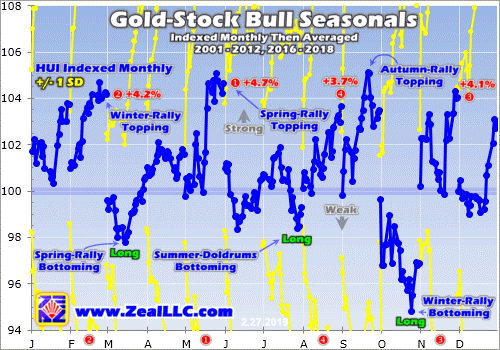
During the 15 Aprils in these modern gold bull-market years, the gold stocks as measured by the HUI saw average gains of 1.6%. But the lion’s share of the spring-rally gains came in May, where average gains nearly tripled to 4.7%! For decades if not longer, May has been one of the best and most-important months to be heavily long gold miners’ stocks. Only February and November have managed to rival it.
The key to gold stocks’ spring rally is to get your capital deployed by mid-March, when gold stocks swoon to their spring-rally bottoming. In intra-month terms the initial gains are often fast in late March as gold stocks rebound out of their seasonal lull. But then the spring rally tends to slow down in mid-April, which invariably discourages impatient and short-sighted traders. The real gains come in May, when gold stocks surge.
Of course the standard seasonality caveat applies that these are mere tendencies, not primary drivers of gold or gold stocks. Seasonal tailwinds can be easily drowned out by bearish sentiment, technicals, and fundamentals. Seasonality doesn’t always work, especially when it doesn’t align with the primary drivers of sentiment, technicals, and fundamentals in that order. Thankfully that certainly isn’t the case this year.
Gold-stock sentiment is growing increasingly bullish as this sector’s solid upleg gathers steam. Seeing higher lows and higher highs on balance further feeds into positive psychology, and traders love to chase momentum in rallying sectors. Mounting stock-market fears of a young bear getting underway should continue to push gold investment demand higher. The resulting higher gold prices really boost mining profits.
Outsized gold-stock gains during this spring-rally timeframe are fully justified fundamentally when gold itself is rallying. When sentiment, technicals, fundamentals, and seasonals all align behind gold stocks, they often surge dramatically higher. Unfortunately most speculators and investors won’t realize this until most of the spring-rally gains have already been won. Buy low in mid-March instead of buying high in early June!
While you can ride gold stocks’ spring rally higher in GDX, the major miners dominating it are struggling to grow their production. Far-better gains will be won in smaller mid-tier and junior gold miners with superior fundamentals. The best are increasing their output through new mine builds and expansions, which also lowers their costs further boosting their profits. Their upside potential utterly trounces that of the GDX majors.
The earlier you get deployed, the greater your gains will be. That’s why the trading books in our popular weekly and monthly newsletters are currently full of better gold and silver miners mostly added in recent months. The gains we won in 2016 were amazing the last time American stock investors returned to gold. Our newsletter stock trades that year averaged +111.0% and +89.7% annualized realized gains respectively!
The gold-stock gains should get really big as today’s young gold and gold-stock uplegs grow. The gold miners are the last undervalued sector in these still-expensive stock markets, and rally with gold during stock-market bears unlike anything else. To multiply your wealth in the stock markets you have to do your homework and stay abreast, which our newsletters really help. They explain what’s going on in the markets, why, and how to trade them with specific stocks. You can subscribe today for just $12 per issue!
The bottom line is gold stocks often experience a strong spring rally seasonally. This is driven by gold’s own seasonality, where outsized investment demand arises at certain times during the calendar year. Gold usually enjoys a solid spring rally likely driven by the universal optimism this season brings. And since gold drives gold miners’ profitability, their stock prices naturally follow it higher while amplifying its gains.
This year’s coming spring rally is due to start in mid-March, with great potential to grow much larger than normal. Gold-stock sentiment is slowly improving as this sector’s current upleg continues grinding higher on balance. And higher gold prices driven by renewed investment demand on stock-market-selloff fears is really boosting gold-mining earnings. All this with strong seasonal tailwinds should fuel an outsized spring rally.
Adam Hamilton, CPA
March 4, 2019
Copyright 2000 – 2019 Zeal LLC (www.ZealLLC.com)
First Vanadium (TSX-V: FVAN) is one of the better known vanadium companies. Its CEO, Paul Cowley, can be seen in a number of video clips that I linked to at the bottom of the page. Despite being a blue chip name, First Vanadium’s market cap is just US$19.5 M. This, for a company that claims to have the highest-grade primary vanadium project in North America, and a plan to fast-track its flagship project in Nevada. To top it all off, management just released a summary of their Maiden mineral resource estimate.
The Maiden mineral resource estimate came in at 303 M Indicated pounds @ 0.615% & 75 M Inferred pounds @ 0.52%. That represents a moderate increase in size & grade from the historical resource estimate of 289 M Inferred pounds @ 0.515%. Importantly, 80% of the new resource (in pounds) is in the Indicated category. At the current vanadium pentoxide price of US$17.60/lb., the in-situ value of First Vanadium’s 303 M Indicated pounds alone = US$ 5.33 billion. That’s about 275x its market cap. Note: {in-situ values can be misleading for early-stage projects, but they can be compared to peers at similar stage}.
Is vanadium for real? Will Vanadium Redox Flow Batteries cause demand & prices of vanadium pentoxide (“V2O5“) to soar? Will global infrastructure projects demand greatly increased amounts of vanadium-strengthened steel rebar? Please continue reading for answers to these and many other important questions. Note: Peter Epstein and Epstein Research have no prior or existing relationship with CEO Paul Cowley or First Vanadium Corp.
Please give readers the latest snapshot of First Vanadium.
First Vanadium Corp. is focused on vanadium and its advanced-stage Carlin Vanadium project in Nevada, the largest and highest grade primary vanadium deposit in North America. The Company is run by professional geologists & engineers who have worked for Major mining companies in senior positions in exploration, deposit discovery, construction & mining operations.
The company has a tight share structure and is well-funded. We just released a Maiden mineral resource estimate that’s 80% in the Indicated category and that’s larger than our historical resource, which was 100% Inferred. We are very pleased with these results.
Why vanadium, why not lithium, cobalt, graphite, nickel or copper?
All of these minerals are going to be winners in the near future with the inevitable rapid demand increases for these metals with the commercialization of lithium-ion electric batteries in automobiles and vanadium redox flow batteries in large power storage applications. There is just not enough production of these minerals from existing mines to meet the projected demand of this exciting evolution in Battery Technology and commercialization.
In addition, in the case of vanadium, it is chiefly used as an alloy for strengthening steel in infrastructure; rebar, pipelines, airplanes and car frames. CIBC Mellon has estimated that there will be $35 trillion dollars of global infrastructure projects starting over the next 20 years, which will spark big demand for vanadium.

Tell us more about the Carlin Vanadium project.
The Carlin Vanadium project is a black shale-hosted sedimentary bed of high-grade vanadium which is shallow dipping and near-surface, making it ideal for open pit mining. The project’s superior location and infrastructure are added benefits, being located less than 6 miles by road to a major rail hub, a major highway, power and mining community.
Furthermore, the grades are higher, about double that of other Nevada based vanadium projects, and there’s significantly more vanadium metal in our deposit, also about double that of our peers. Our Maiden mineral resource estimate shows the large scale and high grade of the deposit.
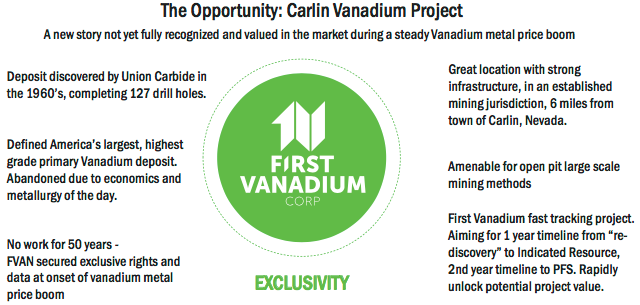
How significant has First Vanadium’s exploration drilling been compared to historical drilling? How many new holes were drilled?
The two drill campaigns that First Vanadium did in 2018 totaling 89 holes were extremely strategic and successful in both in-filling and expanding the deposit. We frequently received assay values with higher grades than those found in the older drill data. This is reflected in our Maiden mineral resource estimate that shows a 0.615% grade in the Indicated category alone. The infill drilling improved the confidence level to justify a high percentage of the resource being in the Indicated category.
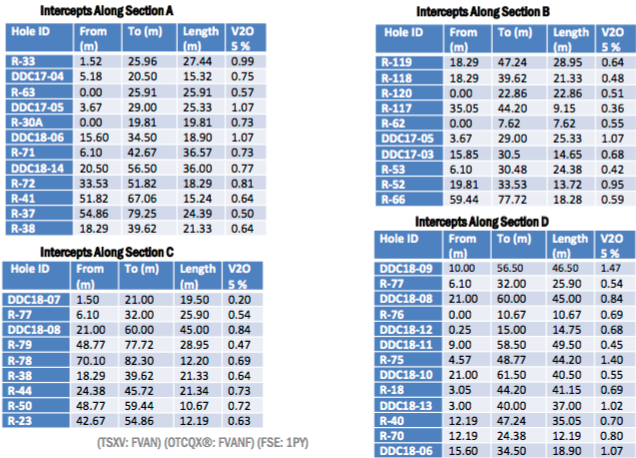
Please explain First Vanadium’s fast-track approach at the Carlin project.
In the 15 months we have had the project, we quickly received permits to drill, conducted two drill campaigns, made significant inroads in metallurgy, conducted environmental studies, and delivered a significant Maiden mineral resource estimate, with 80% of the vanadium in the Indicated category, all to advance the project and unlock value for shareholders. These steps are the normal steps taken by companies to advance and de-risk projects, but normally it would take 3-4 years to accomplish what we have done in 15 months.
Is there too much talk about VRBs, which only represent 1%-2% of vanadium use? Is the VRB opportunity possibly overrated?
The Vanadium Redox Flow Battery has only just started to be commercialized over the last two years and currently draws a small percentage of global vanadium consumption. It will ramp up in the short and intermediate time frame to become a much more significant part of vanadium consumption. For example, one project alone in China, the Dalian project, is expected to consume 7,000 tonnes of vanadium, ~8% of annual production, the equivalent of powering 100,000 homes. You can see that the scaling opportunity is eye-opening.
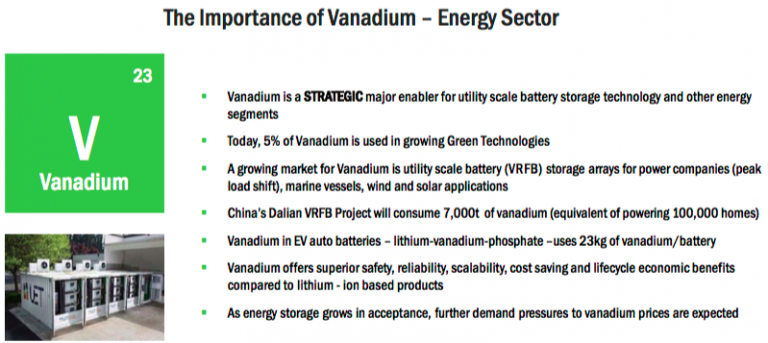
The VRB battery is a superior battery for storing large amounts of electricity and they are forecast to last 25 years, whereas the equivalent lithium-ion battery needs to be replaced every 3 to 5 years due to its depleting characteristics. The VRB battery is the ideal battery solution for the green energy space for large-capacity electricity storage in power grids and in wind & solar applications. Some have stated that if vanadium prices are too high, the VRB battery will not be completive, but continuing technical advancements are being made to bring costs down. Some vanadium producers are offering to lease the vanadium in the battery to reduce costs to the end user.
What do you make of the sharp decline in vanadium prices in Q4 2018?
Vanadium was the best performing metal in 2018, despite the pull-back at the end of the year. September & October 2018 saw a rapid increase in vanadium prices leading up to the implementation of the announced November 1st, 2018 Chinese law requiring 30% more vanadium in Chinese rebar. Rapid price increases are normally followed by pull-backs as a normal reactionary correction, but eventually that pull-back over-reaction needed to stabilize and reflect more prevailing supply & demand factors.
Naturally, the reason for the run-up in price is real and is expected to add more demand to the stage. The strong demand for the metal, and the tight supply, are still the norm– forcing prices up. From mid-January to late-February, the Chinese price of vanadium pentoxide is up 12.8% from US$15.60 to US$17.60/lb. (see chart below from vanadiumprice.com). We expect 2019 will be another strong year for vanadium prices.
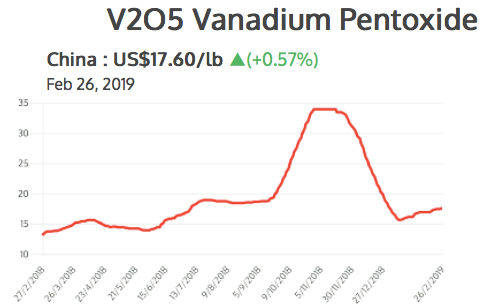
What’s the biggest risk to the Carlin project in the next 12 months?
Perceptions. In the valuations of vanadium projects and their in-situ assets, and in vanadium price performance and trajectory through 2019 to provide the investor with confidence and interest in the future of this metal.
Thank you Paul, that was very helpful, I think that readers should have a much better understanding of First Vanadium after reading this interview. Congratulations on your Maiden mineral resource estimate, and continued good luck on fast-tracking the Carlin Vanadium project.
Peter Epstein
March 1, 2019
Video clips of CEO Paul Cowley and/or First Vanadium Corp.
https://www.youtube.com/watch?v=SEsx6wPCQiM&t=9s
https://www.youtube.com/watch?v=THrnsK_ODwU&t=97s
https://www.youtube.com/watch?v=mdx-TFega1Q
If you would like to receive our free newsletter via email, simply enter your email address below & click subscribe.
CONNECT WITH US
Tweets
Tweet with hash tag #miningfeeds or @miningfeeds and your tweets will be displayed across this site.
MOST ACTIVE MINING STOCKS
Daily Gainers
 Lincoln Minerals Limited Lincoln Minerals Limited |
LML.AX | +125.00% |
      |
GCR.AX | +33.33% |
      |
CASA.V | +30.00% |
      |
AHN.AX | +22.22% |
      |
ADD.AX | +22.22% |
      |
AZM.V | +21.98% |
      |
NSE.V | +21.05% |
      |
DYG.V | +18.42% |
      |
AAZ.V | +18.18% |
      |
GLA.AX | +17.65% |

 Follow us on Twitter
Follow us on Twitter Become our facebook fan
Become our facebook fan








